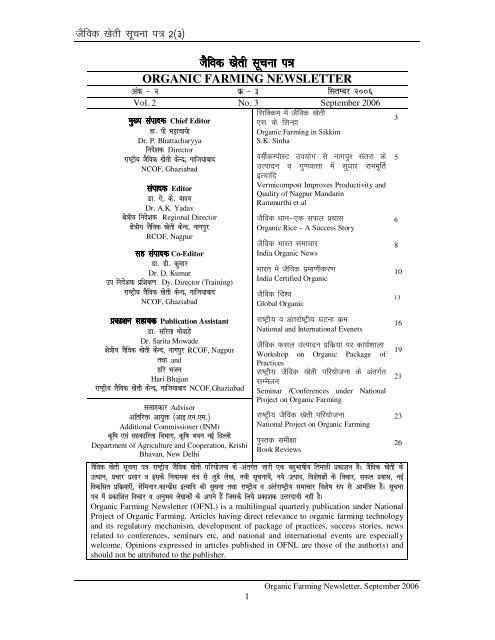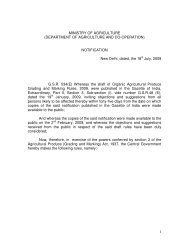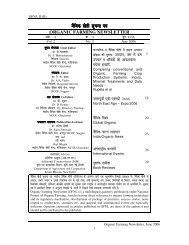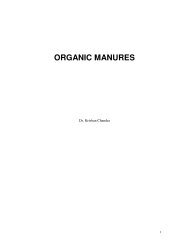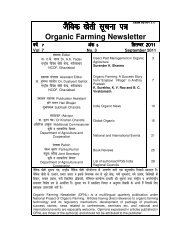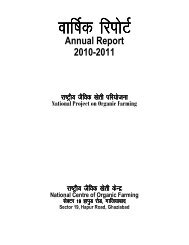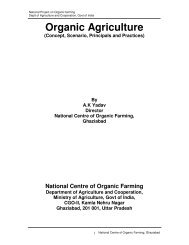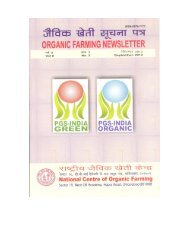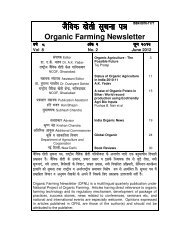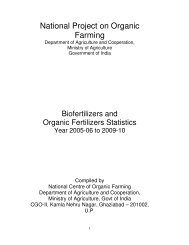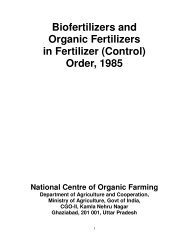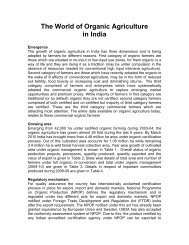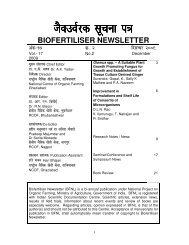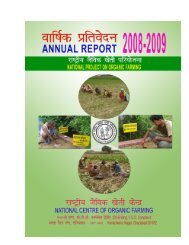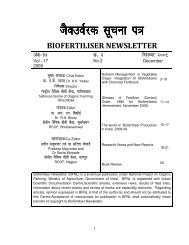organic farming newsletter - National Centre of Organic Farming
organic farming newsletter - National Centre of Organic Farming
organic farming newsletter - National Centre of Organic Farming
You also want an ePaper? Increase the reach of your titles
YUMPU automatically turns print PDFs into web optimized ePapers that Google loves.
tSfod [ksrh lwpuk i= 2¼3½<br />
tSfod tSfod [ksrh [ksrh lwpuk lwpuk lwpuk i=<br />
i=<br />
ORGANIC FARMING NEWSLETTER<br />
vad & 2 dz & 3 flrEcj 2006<br />
Vol. 2 No. 3 September 2006<br />
eq[; eq[; laiknd laiknd laiknd Chief Editor<br />
Mk- ih HkÍkpk;Zk<br />
Dr. P. Bhattacharyya<br />
funs'kd Director<br />
jk"Vªh; tSfod [ksrh dsUn]z xkft;kckn<br />
NCOF, Ghaziabad<br />
laiknd laiknd Editor<br />
Mk- ,s- ds- ;kno<br />
Dr. A.K. Yadav<br />
{ks=h; funs'kd Regional Director<br />
{ks=h; tSfod [ksrh dsUn] ukxiqj<br />
RCOF, Nagpur<br />
lg lg lg laiknd laiknd Co-Editor<br />
Mk- Mh- dqekj<br />
Dr. D. Kumar<br />
mi funs'kd izf'k{k.k Dy. Director (Training)<br />
jk"Vªh; tSfod [ksrh dsUn]z xkft;kckn<br />
NCOF, Ghaziabad<br />
izdk'ku izdk'ku lgk;d lgk;d Publication Assistant<br />
Mk- lfjrk eksokMs<br />
Dr. Sarita Mowade<br />
{ks=h; tSfod [ksrh dsUn] ukxiqj RCOF, Nagpur<br />
rFkk and<br />
gfj Hktu<br />
Hari Bhajan<br />
jk"Vªh; tSfod [ksrh dsUn]z xkft;kckn NCOF,Ghaziabad<br />
lykgdkj Advisor<br />
vfrfjä vk;qä ¼vkb-,u-,e-½<br />
Additional Commissioner (INM)<br />
d`f"k ,oa lgdkfjrk foHkkx] d`f"k Hkou ubZ fnYyh<br />
Department <strong>of</strong> Agriculture and Cooperation, Krishi<br />
Bhavan, New Delhi<br />
1<br />
flfDde esa tSfod [ksrh<br />
,l- ds- flUgk<br />
<strong>Organic</strong> <strong>Farming</strong> in Sikkim<br />
S.K. Sinha<br />
oehZdEiksLV mi;ksx ls ukxiqj larjk ds<br />
mRiknu o xq.koRrk esa lq/kkj jkeewfrZ<br />
bR;kfn<br />
Vermicompost Improves Productivity and<br />
Quality <strong>of</strong> Nagpur Mandarin<br />
Rammurthi et al<br />
tSfod /kku&,d lQy iz;kl<br />
<strong>Organic</strong> Rice – A Success Story<br />
tSfod Hkkjr lekpkj<br />
India <strong>Organic</strong> News<br />
Hkkjr esa tSfod izek.khdj.k<br />
India Certified <strong>Organic</strong><br />
tSfod fo”o<br />
Global <strong>Organic</strong><br />
jk’Vªh; o varjkZ’Vªh; ?kVuk dze<br />
<strong>National</strong> and International Evenets<br />
tSfod Qly mRiknu izfdz;k ij dk;Z”kkyk<br />
Workshop on <strong>Organic</strong> Package <strong>of</strong><br />
Practices<br />
jk’Vªh; tSfod [ksrh ifj;kstuk ds varxZr<br />
lEesyu<br />
Seminar /Conferences under <strong>National</strong><br />
Project on <strong>Organic</strong> <strong>Farming</strong><br />
jk’Vªh; tSfod [ksrh ifj;kstuk<br />
<strong>National</strong> Project on <strong>Organic</strong> <strong>Farming</strong><br />
iqLrd leh{kk<br />
Book Reviews<br />
tSfod [ksrh lwpuk i= jk"Vªh; tSfod [ksrh ifj;kstuk ds varxZr tkjh ,d cgqHkk"kh; frekgh izdk'ku gSA tSfod [ksrh ds<br />
mRFkku] izpkj izlkj o blds fu;ked ra= ls tqMs ys[k] u;h lwpuk;sa] u;s mRikn] fo'ks"kKksa ds fopkj] lQy iz;kl] ubZ<br />
fodflr izfdz;k,sa] lsfeukj-dkUQzsal bR;kfn dh lwpuk rFkk jk"Vªh; o varZjk"Vªh; lekpkj fo'ks"k #i ls vkeaf=r gSaA lwpuk<br />
i= esa izdkf'kr fopkj o vuqHko ys[kdksa ds vius gSa ftlds fy;s izdk'kd mÙkjnk;h ugha gSA<br />
<strong>Organic</strong> <strong>Farming</strong> Newsletter (OFNL) is a multilingual quarterly publication under <strong>National</strong><br />
Project <strong>of</strong> <strong>Organic</strong> <strong>Farming</strong>. Articles having direct relevance to <strong>organic</strong> <strong>farming</strong> technology<br />
and its regulatory mechanism, development <strong>of</strong> package <strong>of</strong> practices, success stories, news<br />
related to conferences, seminars etc, and national and international events are especially<br />
welcome. Opinions expressed in articles published in OFNL are those <strong>of</strong> the author(s) and<br />
should not be attributed to the publisher.<br />
<strong>Organic</strong> <strong>Farming</strong> Newsletter, September 2006<br />
3<br />
5<br />
6<br />
8<br />
10<br />
13<br />
16<br />
19<br />
21<br />
23<br />
26
tSfod [ksrh lwpuk i= 2¼3½<br />
laikndh;<br />
laikndh;<br />
laikndh; From Editor's Desk<br />
fiz; ikBdks<br />
tSfod [ksrh dh cko o lykg<br />
lHkh lacaf/kr yksxksa rd igq¡pk ldrs gSaA<br />
Dear Readers<br />
With wider acceptability <strong>of</strong> <strong>organic</strong> <strong>farming</strong> among farmers, there is an urgent<br />
need for systematic documentation <strong>of</strong> <strong>organic</strong> packages <strong>of</strong> different crops suited<br />
to different ecological regions. Experiences <strong>of</strong> successful <strong>organic</strong> farmers also<br />
need to be incorporated and promoted. Food and Agriculture organization (FAO)<br />
and <strong>National</strong> <strong>Centre</strong> <strong>of</strong> <strong>Organic</strong> <strong>Farming</strong> (NCOF) are trying to compile first such<br />
document, which is likely to be published by October 2006. I call upon the<br />
farmers, scientists and <strong>organic</strong> <strong>farming</strong> promoters to share more and more <strong>of</strong> such<br />
knowledge, generated by our field scientists with the readers <strong>of</strong> this Newsletter.<br />
Certified <strong>organic</strong> area, an index <strong>of</strong> growth, is also growing faster and has<br />
more than doubled in last three years. Efforts have also been made in this issue to<br />
present the realistic state-wise picture <strong>of</strong> total certified area in the country.<br />
Planning Commission is in the process <strong>of</strong> finalization <strong>of</strong> next five years plan<br />
document and intends to give major boost to <strong>organic</strong> <strong>farming</strong>. I invite all those<br />
who would like to share their views and opinion for policy build up <strong>of</strong> the<br />
country. <strong>Organic</strong> <strong>Farming</strong> Newsletter is an ideal forum for carrying their views to<br />
the appropriate forum.<br />
v'kksd v'kksd dqekj dqekj ;kno ;kno A.K. Yadav<br />
laiknd laiknd Editor<br />
2<br />
<strong>Organic</strong> <strong>Farming</strong> Newsletter, September 2006
tSfod [ksrh lwpuk i= 2¼3½<br />
<strong>Organic</strong> <strong>Farming</strong> in Sikkim<br />
S.K. Sinha<br />
Department <strong>of</strong> Food Security and Agriculture Development<br />
Tadong, Sikkim<br />
Sikkim an Overview<br />
Sikkim being the first declared <strong>organic</strong> state<br />
in the North Eastern Region is taking rapid<br />
strides in converting the agrarian agricultural<br />
practices <strong>of</strong> the state to fully <strong>organic</strong> based.<br />
The tiny state <strong>of</strong> Sikkim in the Himalayan<br />
Region spreads over 7,096 sq. kilometers, <strong>of</strong><br />
which, nearly 1,10,000 ha is available for<br />
cultivation. The net sown area is estimated to<br />
be around 79,000 ha. Rain-fed agriculture is<br />
a predominant feature, having only about<br />
15% area under irrigation. Main crops grown<br />
in the state are maize, pulses, oilseeds,<br />
millets, buckwheat etc. Due to hilly terrain<br />
and small-holdings, mixed <strong>farming</strong> is the<br />
most suited <strong>farming</strong> system. Entire state is<br />
hilly with no plain land. The agro-climatic<br />
conditions range from sub-tropical type in<br />
the lower valley to alpine conditions in the<br />
upper reaches. Less than 30% <strong>of</strong> land has<br />
been classified as the land <strong>of</strong> capacity class I.<br />
Cultivation is done in slopping topography<br />
with or without proper bench terracing.<br />
Strategy<br />
The Department <strong>of</strong> Food Security and<br />
Agriculture Development is spearheading the<br />
task <strong>of</strong> converting the state to fully <strong>organic</strong><br />
agriculture state with following strategy:<br />
� Phasing out <strong>of</strong> fertilizer consumption<br />
� Identification <strong>of</strong> <strong>organic</strong> sources <strong>of</strong><br />
nutrients<br />
� Transfer <strong>of</strong> technology-ensuring farmer’s<br />
participation on the <strong>organic</strong> <strong>farming</strong><br />
system<br />
� Human resource development<br />
� Creation <strong>of</strong> infrastructure for<br />
implementing various programmes like<br />
establishment <strong>of</strong> bi<strong>of</strong>ertilizer production<br />
unit and the upgradation <strong>of</strong> soil testing<br />
laboratories.<br />
3<br />
� Substituting pesticides with eco-friendly<br />
<strong>organic</strong>s<br />
� Encouraging alternative and integrated<br />
pest management approach.<br />
Priority<br />
Being the first to go <strong>organic</strong> the States’<br />
efforts need enduring support from all<br />
related players and stakeholders to ensure<br />
that the State actually reap benefits,<br />
particularly in terms <strong>of</strong> rural farmer, who<br />
struggle all his life to make both ends meet.<br />
Realizing the hilly nature <strong>of</strong> the State, where<br />
productivity <strong>of</strong> food grains can not increased<br />
dramatically, emphasis is more on<br />
commercial crops, fruits and <strong>of</strong>f-season<br />
vegetables that have tremendous scope and<br />
are fetching good market prices outside the<br />
state.<br />
Programmes being implemented by the<br />
Department<br />
Reduction in fertilizer use – Subsidy on<br />
fertilizers is being reduced at 10% per year<br />
since 2003-04. The subsidy component<br />
during the year 2006-07 is zero. Overall<br />
fertilizer consumption has been reduced to<br />
just 1.64 (NPK) kg/ha during 2005-06 (Table<br />
1). Department has already stopped<br />
purchasing chemical fertilizers in the<br />
schemes and relying only on <strong>organic</strong> sources<br />
<strong>of</strong> nutrients. Demonstration trials are being<br />
carried out at farmers’ fields using improved<br />
<strong>organic</strong> manures soil conditioners and<br />
<strong>organic</strong> fertilizers.<br />
<strong>Centre</strong>s <strong>of</strong> excellence - Two Government<br />
farms have been converted into the centers <strong>of</strong><br />
excellence for <strong>organic</strong> <strong>farming</strong>, with all the<br />
necessary facilities.<br />
<strong>Organic</strong> <strong>Farming</strong> Newsletter, September 2006
tSfod [ksrh lwpuk i= 2¼3½<br />
Table 1. Chemical fertilizer consumption<br />
during 2005-06.<br />
Fertilizer Consumption in tonnes<br />
In terms <strong>of</strong> In terms <strong>of</strong><br />
Material nutrients<br />
Urea 187.3 112.40(N)<br />
DAP 145.55 67.00(P)<br />
MOP 2.00 1.2 (K)<br />
Total 334.85 180.6<br />
Composting - Rural composting is being<br />
encouraged at massive scale by providing<br />
financial assistance to farmers. A new<br />
technology for making urine pit along with<br />
the rural composting pit has been introduced<br />
and is getting popularized.<br />
EM-Technology -100 villages are being<br />
converted to Bio-villages using EMtechnology.<br />
Initially 30 farmers are being<br />
selected in each <strong>of</strong> these villages for<br />
conversion with the further aim to bring all<br />
the farmers in due course.<br />
Vermicomposting – Farmers are being<br />
encouraged to produce vermicompost at their<br />
own farms by providing financial assistance.<br />
Two vermicompost production units, one at<br />
Government farm and one at NGO farm,<br />
have been established with 150MT<br />
production capacity/year. A large scale<br />
demonstration programme is underway at<br />
farmers' fields involving on-farm production<br />
<strong>of</strong> vermicompost.<br />
Bi<strong>of</strong>ertilizer – A bi<strong>of</strong>ertilizer production<br />
unit is under final stages <strong>of</strong> construction at<br />
4<br />
Mazitar, using the funds provided by North<br />
Eastern Council. On commissioning in near<br />
future this unit will be catering to the state’s<br />
entire requirement <strong>of</strong> Bi<strong>of</strong>ertilizers with<br />
native microbial strains.<br />
Literatures – For creating awareness, wide<br />
publicity campaigns are being taken and<br />
necessary literature on <strong>organic</strong> <strong>farming</strong> is<br />
being prepared for wide circulation among<br />
farmers.<br />
Trainings and Development <strong>of</strong> model<br />
<strong>organic</strong> farms –Under <strong>National</strong> Project on<br />
<strong>Organic</strong> <strong>Farming</strong> a sum <strong>of</strong> Rs. 19.12 lakh<br />
were sanctioned by Govt <strong>of</strong> India for<br />
organization <strong>of</strong> 24 farmers training<br />
programmes and for establishment <strong>of</strong> 4<br />
model <strong>organic</strong> farms. department <strong>of</strong><br />
Horticulture and Cash Crops Development,<br />
Sikkim has also been provided with a grant<br />
<strong>of</strong> Rs. 49.11 lakh under NPOF for<br />
organization <strong>of</strong> various training programmes,<br />
field demonstrations, establishment <strong>of</strong> one<br />
model <strong>organic</strong> farm. 10 No service<br />
providers have also been sanctioned to the<br />
state for arranging certification <strong>of</strong> farmer<br />
groups under internal control system <strong>of</strong><br />
NPOP. All these programmes are in different<br />
stages <strong>of</strong> implementation.<br />
Future strategy<br />
� Conversion <strong>of</strong> agrarian practices <strong>of</strong> the<br />
state from in<strong>organic</strong> to fully <strong>organic</strong><br />
based <strong>farming</strong> through development and<br />
standardization <strong>of</strong> package <strong>of</strong> practices<br />
for <strong>organic</strong> crop management.<br />
� Identifying <strong>organic</strong> sources <strong>of</strong> crop<br />
production and protection for reduction<br />
<strong>of</strong> dependence on chemical sources.<br />
� Strengthen farmer-level self sustaining<br />
<strong>organic</strong> crop production process.<br />
� Reduce adverse impact on the<br />
environment and natural resources.<br />
<strong>Organic</strong> <strong>Farming</strong> Newsletter, September 2006
tSfod [ksrh lwpuk i= 2¼3½<br />
Vermicompost improves productivity and<br />
quality <strong>of</strong> Nagpur mandarin<br />
V. Ramamurthy, Jagdish Prasad, V.N. Prahad and V. Thakre<br />
<strong>National</strong> Bureau <strong>of</strong> Soil Survey and Land Use Planning, Nagpur, India<br />
Vermicompost application is one <strong>of</strong> the<br />
effective methods to rejuvenate the depleted<br />
soil fertility, enrich the available pool <strong>of</strong><br />
nutrients, maintain soil quality and conserve<br />
more water and more biological resources<br />
(Pimental et al 2005). With this background<br />
an on-farm study was taken on 10 farmers'<br />
field in 10 year old orange orchards in<br />
typical expansive clay soils <strong>of</strong> Vidarbha<br />
region in Central India. Three treatments in<br />
1000m 2 plots, viz: T1-20 kg FYM/tree, T2-<br />
50 kg FYM+600:200:100g NPK/tree and T3-<br />
5 kg vermicompost and 20 kg FYM were<br />
subjected to study during 2001 to 2004.<br />
Yield, yield attributes and quality parameters<br />
were recorded on five randomly selected<br />
trees from each treatment plot during 2003<br />
and 2004.<br />
The nutrient status in terms <strong>of</strong> N, P, K, Ca<br />
and Mg (in %) was 0.5, 0.2, 0.5, 0.9 and 0.2<br />
in FYM and 1.6, 0.7, 0.8, 0.5 and 0.2 in<br />
vermicompost respectively. Fe, Mn, Cu and<br />
Zn were at the level <strong>of</strong> 146, 69.0, 2.8 and<br />
14.5 in FYM and 175, 96.5, 5.0 and 24.5 mg<br />
kg 1 in FYM and vermicompost respectively.<br />
Application <strong>of</strong> vermicompost + FYM in T3<br />
recorded significantly higher number <strong>of</strong><br />
fruits, fruit weight and yield in both the years<br />
compared to other two treatments.<br />
Application <strong>of</strong> vermicompost was not only<br />
5<br />
found to improve the yield and yield<br />
attributes, but has also suitably modified the<br />
physical and biological properties <strong>of</strong> soil.<br />
Similar views were also reported by<br />
Srivastava and Singh (2004). The increase in<br />
number <strong>of</strong> fruits, fruit weight and yield in T3<br />
was 7, 18 and 46% over T1 and 4, 15 and<br />
41% over T2 (see Table 1). Vermicompost<br />
application also improved porosity, internal<br />
drainage <strong>of</strong> soils and nutrient content <strong>of</strong> soil.<br />
Increased conservation <strong>of</strong> water led to low<br />
fruit drop, higher fruit number and fruit<br />
weight. Application <strong>of</strong> vermicompost<br />
improved the TSS and juice content <strong>of</strong> fruits<br />
significantly (Table 1). Increased TSS and<br />
juice contents inT3 was attributed to<br />
regulated nutrient supply due to<br />
vermicompost application.<br />
Table 1. Effect <strong>of</strong> vermicompost on Nagpur<br />
mandarin (Mean <strong>of</strong> two years)<br />
Parameter Treatments<br />
T1 T2 T3 CD at<br />
5%<br />
2003/20<br />
04<br />
No <strong>of</strong> 795 824 858 24.3/24.<br />
fruits/tree<br />
Weight <strong>of</strong><br />
fruit (g)<br />
124 128 152 8.7/9.0<br />
Fruit yield<br />
(T/ha)<br />
28 30 52 2.2/2.1<br />
TSS (%) 9.6 10.5 10.8 0.19/0.4<br />
Juice (%) 38.7 41.2 43.3 1.27/0.7<br />
References<br />
Piemental, D., Hepperly, P, Hansen, J.<br />
Dodus, D. and Seidel, R. 2005. Bioscience<br />
55(7) : 573-582.<br />
Srivastava, A.K. and Singh, S. 2004. Tech<br />
Bull 8, NRC for Citrus, Nagpur, pp130.<br />
<strong>Organic</strong> <strong>Farming</strong> Newsletter, September 2006
tSfod [ksrh lwpuk i= 2¼3½<br />
Shri Ponumatsa Peddi Raju, a small farmer<br />
<strong>of</strong> Polamuru village in Ponuimantra Mandal,<br />
West Godawari District <strong>of</strong> Andhra Pradesh<br />
has successfully adopted a package <strong>of</strong><br />
<strong>organic</strong> rice cultivation in consultation with<br />
"Technology Extension Societ,<br />
Veeravasaram" and Department <strong>of</strong><br />
Agriculture, Andhra Pradesh. "Ankur<br />
Sonam" variety was tested under the<br />
package. Details <strong>of</strong> his <strong>organic</strong> package and<br />
input and output statistics per one acre is<br />
presented here in his own words.<br />
Soil enrichment and nutrition supply is<br />
managed by the application <strong>of</strong> 5 ton <strong>of</strong> cattle<br />
dung manure, 500 kg vermicompost, 80 kg<br />
neem cake, 50 kg ground nut cake and 50 kg<br />
castor oil cake. Some quantity <strong>of</strong> waste<br />
tobacco plants were also added along with<br />
compost. While dung manure and<br />
vermicompost was applied for soil<br />
enrichment and nutrition, oil cakes were used<br />
to encourage the growth <strong>of</strong> friendly<br />
micr<strong>of</strong>lora and fauna and restrict the growth<br />
<strong>of</strong> soil borne pathogens and pests.<br />
Azospirillum, PSB and BGA bi<strong>of</strong>ertilizers<br />
were also used in recommended doses for<br />
harvesting atmospheric nitrogen and for<br />
solubilizing fixed soil phosphorus. Various<br />
EM formulations such as EM-1, EM-3 and<br />
EM-5 were frequently used as per the<br />
recommended methods. Besides, these no<br />
other input, synthetic or otherwise, was used.<br />
For insect pest management, neem oil,<br />
custard apple leaf extract fermented with<br />
EM-2, tobacco-leaf extract and garlic-gingerchilli<br />
extract were used at different growth<br />
stages for the control <strong>of</strong> different insects.<br />
<strong>Organic</strong> Rice<br />
A Success Story<br />
Ponumatsa Peddi Raju<br />
Polamuru, West Godawari, Andhra Pradesh<br />
6<br />
Right from the first year I am getting an<br />
average productivity <strong>of</strong> 2250 kg/acre (5.625<br />
t/ha). As per my calculation total cost <strong>of</strong><br />
inputs used per acre was Rs. 3685/-<br />
(including the prevailing market price <strong>of</strong><br />
home grown cattle dung manure,<br />
vermicompost, oilcakes, garlin, ginger, chilli<br />
etc). Total cost in terms <strong>of</strong> labour (for land<br />
preparation, nursery raising, transplantation,<br />
weeding, spraying, harvesting and threshing)<br />
was Rs. 3550/-. Out <strong>of</strong> the total cost <strong>of</strong> Rs.<br />
7235/- per acre, cost <strong>of</strong> purchased inputs<br />
(EM, oil cakes and bi<strong>of</strong>ertilizers) was only<br />
Rs. 1500/-, while other inputs were on-farm<br />
produce. Similarly 50% <strong>of</strong> the labour cost<br />
was also from the self and family members.<br />
As my rice was <strong>organic</strong>, grown without the<br />
use <strong>of</strong> chemicals, I fetched very good price.<br />
<strong>Organic</strong> <strong>Farming</strong> Newsletter, September 2006
tSfod [ksrh lwpuk i= 2¼3½<br />
During the year 2005-06 season my rice was<br />
sold at Rs. 1000/- per bag <strong>of</strong> 75 kg each<br />
(Rs.13.33 per kg). With this premium my net<br />
income was Rs. 22,765/- per acre (total sale<br />
value Rs. 30,000/- minus cost <strong>of</strong> cultivation<br />
Rs. 7235/-). Even if it is assumed that I do<br />
not fetch any premium price then my rice<br />
would be sold at half the price and still be<br />
giving a net pr<strong>of</strong>it <strong>of</strong> Rs. 7765/- which is<br />
much higher then what farmers are<br />
harvesting by conventional <strong>farming</strong> methods.<br />
7<br />
Now Shri Peddi Raju is a happy farmer, he<br />
has his own cattle, he has developed his own<br />
composting and vermicomposting production<br />
units and almost all inputs (except EM and<br />
bi<strong>of</strong>ertilizers) are generated on his own farm<br />
or in the village. This way he is not only<br />
helping his soil and environment to remain<br />
healthy, but is also contributing to rural<br />
wealth generation, in which sale proceeds are<br />
not paid to industries and market forces, but<br />
are utilized locally for the benefit <strong>of</strong> rural<br />
people.<br />
NPOP gets Equivalence in European Union<br />
After USA, now European Union has also granted equivalence to the <strong>National</strong> Programme<br />
on <strong>Organic</strong> Production (NPOP) <strong>of</strong> India. The Commission <strong>of</strong> the European Communities,<br />
vide Commission Regulation (EC) No. 956/2006 <strong>of</strong> 28 th June 2006, amending Regulation<br />
(EEC) No. 94/92 as regards the list <strong>of</strong> third countries from which certain agricultural<br />
products obtained by <strong>organic</strong> production must originate to be marketed with in the<br />
community. The amendment specifies that the rules governing production and inspection <strong>of</strong><br />
agricultural products are equivalent to those laid down in regulation (EEC) No. 2092/91.<br />
The Commission has carried out an on-the-spot-check <strong>of</strong> the rules <strong>of</strong> production and the<br />
inspection measures actually applied in India, as provided for in article 11(5) <strong>of</strong> regulation<br />
(EEC) No. 2092/91.<br />
The essentials <strong>of</strong> the said regulation are as follows:<br />
Approved product categories<br />
a. Unprocessed crop products within the meaning <strong>of</strong> Article 1(1)(a) <strong>of</strong> regulation<br />
(EEC) No. 2092/91<br />
b. Foodstuffs composed essentially <strong>of</strong> one or more ingredients <strong>of</strong> plant origin with in<br />
the meaning <strong>of</strong> Article 1(1)(b) <strong>of</strong> regulation (EEC) No. 2092/91<br />
Origin – Products <strong>of</strong> category 1(a) and <strong>organic</strong>ally grown ingredients in products <strong>of</strong><br />
category 1(b) that have been grown in India.<br />
Inspection and Certification bodies – All eleven certification and inspection bodies<br />
accredited by the APEDA under NPOP have been accepted as authorized inspection and<br />
certification bodies under the said regulation.<br />
Duration <strong>of</strong> the inclusion – 30.06.2009.<br />
To make the NPOP an internationally acceptable mechanism, efforts are also on to obtain<br />
equivalence from other countries also. Recently NPOP has been accepted by the<br />
Switzerland. Among third countries India is the only country whose <strong>organic</strong> certification<br />
mechanism has been accepted by the USA, EU and Switzerland. This is likely to give a<br />
phenomenonal boost to the export <strong>of</strong> <strong>organic</strong> products.<br />
<strong>Organic</strong> <strong>Farming</strong> Newsletter, September 2006
tSfod [ksrh lwpuk i= 2¼3½<br />
<strong>Organic</strong> <strong>farming</strong> could be useful to<br />
increase agricultural productivity both<br />
qualitatively and quantitatively – The<br />
Minister <strong>of</strong> Agriculture and Cooperatives,<br />
Jammu and Kashmir, Jenab Abdul Aziz<br />
Zargar, while addressing the trainess in a ten<br />
days training course, organized by Regional<br />
<strong>Centre</strong> <strong>of</strong> <strong>Organic</strong> <strong>Farming</strong>, Hisar stated that<br />
statistics reveal that contribution <strong>of</strong><br />
agriculture to GDP is continuously showing<br />
a declining trend, which need to be checked<br />
by improving soil status and transfer <strong>of</strong> latest<br />
farm technology to increase productivity,<br />
both qualitatively and quantitatively.<br />
Introduction <strong>of</strong> <strong>organic</strong> <strong>farming</strong> could be<br />
fruitful means to achieve this cherished goal<br />
(RCOF, Hisar).<br />
<strong>Organic</strong> Yields Better -First Annual<br />
Progress Report <strong>of</strong> Department <strong>of</strong> Agronomy<br />
and Agromet, Punjab Agricultural<br />
University, Ludhiana, under Network Project<br />
on <strong>Organic</strong> <strong>Farming</strong> <strong>of</strong> ICAR, reveals that<br />
<strong>organic</strong> management yield better then<br />
conventional system. In this study five<br />
cropping systems viz: Basmati rice-wheatgreen<br />
manure, Turmeric-onion, summer<br />
ground nut-garlic, Maize-durum wheatcowpea<br />
(fodder) and Rice-garlic+mentha,<br />
were studied under complete <strong>organic</strong>,<br />
complete in<strong>organic</strong> (control) and integrated<br />
systems. <strong>Organic</strong> sources used were FYM,<br />
crop residue, vermicompost, non-edible oil<br />
cakes and sunhemp green manure.<br />
The maize-wheat and basmati rice-wheat<br />
cropping system fared well under <strong>organic</strong><br />
management. The productivity <strong>of</strong> maize<br />
under <strong>organic</strong> management was 37.6 to<br />
46.0q/ha compared to 20.4q/ha in control.<br />
Basmati rice with green manure only gave<br />
45.8% higher productivity then control. The<br />
wheat following maize produced 25.5-<br />
27.8q/ha as against 12.2q/ha in control. The<br />
rice equivalent yield <strong>of</strong> <strong>organic</strong>, in<strong>organic</strong><br />
and integrated were: (a) under rice-<br />
India <strong>Organic</strong> News<br />
8<br />
garlic+mentha 217.3, 193.3 and 275.4, (b)<br />
under summer groundnut-garlic 144.4, 126.1<br />
and 167.9, (c) under maize-wheat-cowpeas,<br />
110.3, 111.1 and 121.7, (d) under basmati<br />
rice-wheat-green manure 113.9, 104.3 and<br />
122.4 and (e) under turmeric onion were<br />
302.7, 186.6 and 381q/ha respectively.<br />
The acidity percentage in <strong>organic</strong> onion was<br />
more under <strong>organic</strong>. In garlic TSS, acidity<br />
and ascorbic acid content improved under<br />
<strong>organic</strong>. Release <strong>of</strong> Trichogramma<br />
japonicum and T. chilonis below economical<br />
threshold limit. Dipping <strong>of</strong> rice in fermented<br />
cow dung-cow urine, manual weeding, neem<br />
oil spray, neem cake application in soil and<br />
foliar spray <strong>of</strong> Trichoderma harzianum<br />
proved effective against insect-pests in rice.<br />
The substantial improvement in <strong>organic</strong><br />
carbon, N,P and K status was recorded under<br />
<strong>organic</strong> management. The corresponding<br />
value ranged between 0.54 to 0.59, 294.8 to<br />
341.8, 40.9 to 51.9 and 161.0 to 179.3<br />
against initial values as 0.34, 277.8, 36.3 and<br />
134.4 respectively. The extent <strong>of</strong><br />
improvement in integrated was also observed<br />
but in chemical the improvement was<br />
comparatively very less.<br />
Natural Pest control Techniques – For<br />
fungal disease and termite control various<br />
indigenous methods have been tried and<br />
published in the literature. Some <strong>of</strong> the<br />
important control measures are described<br />
here:<br />
For fungal disease control<br />
• A mixture <strong>of</strong> ash (2-3 kg) and 1 liter <strong>of</strong><br />
castor oil is spread on a seed bed <strong>of</strong> a<br />
size <strong>of</strong> about 100m 2 . The application is<br />
repeated 2-3 times at intervals <strong>of</strong> 7-10<br />
days. This provides protection against<br />
soil borne diseases in tobacco nurseries.<br />
• A mixture <strong>of</strong> 2 kg <strong>of</strong> turmeric powder<br />
and 8 kg wood ash is used as dust over<br />
leaves for treatment against powdery<br />
mildew.<br />
<strong>Organic</strong> <strong>Farming</strong> Newsletter, September 2006
tSfod [ksrh lwpuk i= 2¼3½<br />
• Ginger powder at 20 gm/lit <strong>of</strong> water and<br />
sprayed thrice at interval <strong>of</strong> 15 days can<br />
also effectively check the incidence <strong>of</strong><br />
powdery mildew and other fungal<br />
diseases.<br />
• Handful <strong>of</strong> slaked lime applied at the<br />
base <strong>of</strong> tomato plant can combat<br />
damping-<strong>of</strong>f disease.<br />
• Cattle and goat urine have fungicidal<br />
properties. Two cups <strong>of</strong> cattle urine with<br />
5ml peppermint oil and 10 lit <strong>of</strong> water<br />
can be used to control fungal diseases on<br />
grapes<br />
For termite control<br />
• Mixture <strong>of</strong> lime and sulphur forked into<br />
the soil discourages termite attack.<br />
• Wood ash heaped around the base <strong>of</strong> the<br />
trunk prevent termite infestation in c<strong>of</strong>fee<br />
bushes and date palms.<br />
• Repeated pouring <strong>of</strong> cattle urine diluted<br />
at 1:6 with water in termite holes helps in<br />
keeping their spread under control.<br />
• Mixture <strong>of</strong> cattle dung and red coloured<br />
clay with water is coated on the trunk<br />
and large twigs at the onset <strong>of</strong> monsoon<br />
when termite damage is severe. Fresh<br />
and young grafts are can also be coated<br />
with it to protect them from termites.<br />
(Source – Natural Crop Protection in the<br />
Tropics – Letting information come to life by<br />
Gabbriele Stoll. Publishers Margraf Verlag<br />
Germany)<br />
<strong>Organic</strong> Cotton beats Bt Cotton – The<br />
benefits <strong>of</strong> <strong>organic</strong> cotton seem to clearly<br />
outweigh those from Bt cotton, whose cost<br />
<strong>of</strong> cultivation in the kharif season <strong>of</strong> 2005<br />
was higher by 67% and income lower by<br />
37%, says a survey by the <strong>Centre</strong> for<br />
Sustainable Agriculture, Hyderabad. The<br />
study conducted in Andhra Pradesh reveals<br />
that the cost <strong>of</strong> cultivation <strong>of</strong> BT cotton per<br />
acre stood at Rs. 8,366/- while the same for<br />
<strong>organic</strong> cotton was Rs. 5,008/-. Net income<br />
per acre from Bt cotton was lower by 37% at<br />
Rs. 3,551 from <strong>organic</strong> cotton, which stood<br />
at Rs. 5,618. However in terms <strong>of</strong> gross<br />
income Bt cotton was ahead <strong>of</strong> <strong>organic</strong><br />
9<br />
cotton, the reason being Bt cotton's higher<br />
average yield <strong>of</strong> 6.14 quintal as against 5.23<br />
quintals <strong>of</strong> latter. The gross income <strong>of</strong> Bt<br />
cotton stood at Rs. 11,918/- but for <strong>organic</strong><br />
cotton it was Rs. 10,627/-. The average<br />
market price for Bt cotton was Rs. 1,941/-,<br />
while for <strong>organic</strong> it was Rs. 2,032/-. The<br />
study was based on season long fortnightly<br />
monitoring <strong>of</strong> 120 Bt cotton fields from five<br />
districts <strong>of</strong> Andhra Pradesh and 123 nonpesticidal<br />
management (NPM)/ <strong>organic</strong><br />
cotton farmers from four districts.<br />
(Source – The Living Field, OFAI<br />
Newsletter, April 2006.<br />
Punjab Farmers visit model <strong>organic</strong> farms<br />
in Vidarbha- To promote <strong>organic</strong> <strong>farming</strong><br />
in Punjab and to provide deep insight <strong>of</strong> the<br />
<strong>organic</strong> technologies, developed by <strong>organic</strong><br />
farmers <strong>of</strong> Vidarbha, Kheti Virasat Mission,<br />
Punjab, organized a visit <strong>of</strong> 12 progressive<br />
farmers <strong>of</strong> Punjab during 17 th to 21 st August<br />
2006. First day the visiting farmers<br />
witnessed the new method <strong>of</strong> rice cultivation,<br />
popularly known as SRI (System <strong>of</strong> Rice<br />
Intensification). In this method only 2 kg <strong>of</strong><br />
rice seed is good enough for one acre and the<br />
nutrient management is exclusively by<br />
<strong>organic</strong> methods. Water requirement is 50%<br />
less than the conventional methods. Yield<br />
averages around 40-55 quintals/ha. Second<br />
day <strong>of</strong> the visit was attributed to mixed<br />
<strong>farming</strong> model <strong>of</strong> Chetna Vikas (a NGO). In<br />
this method 35 crops are grown in one acre<br />
with novel water harvesting techniques. By<br />
this method a farmer can earn a net income<br />
<strong>of</strong> Rs. 15,000/- per ha, with 85% <strong>of</strong> his<br />
nutritional and food needs. As the model was<br />
rainfed based, farmers were <strong>of</strong> the opinion<br />
that this model may not be suitable under<br />
irrigated conditions <strong>of</strong> Punjab. Third day <strong>of</strong><br />
the visit was on the farm <strong>of</strong> two very<br />
prominent <strong>organic</strong> farmers Viz Shri Anand<br />
Subedar and Shri Subhash Sharma. On last<br />
day <strong>of</strong> the visit they visited few small<br />
<strong>organic</strong> farmers <strong>of</strong> village Mandwa. Farmers<br />
left for their home state after paying their<br />
tributes to the father <strong>of</strong> Nation at Sewgram.<br />
(Source–Sh. Ajay Tigaonkar, MOFF).<br />
<strong>Organic</strong> <strong>Farming</strong> Newsletter, September 2006
tSfod [ksrh lwpuk i= 2¼3½<br />
<strong>Organic</strong> <strong>farming</strong> is growing at very fast pace<br />
in India. The movement started with few<br />
enthusiastic NGOs has taken deep root and is<br />
being given due importance in various<br />
agricultural policies <strong>of</strong> Central and State<br />
Governments. With the introduction <strong>of</strong><br />
<strong>National</strong> Programme on <strong>Organic</strong> Production<br />
(NPOP), certification has assumed<br />
significant proportion. Total certified<br />
cultivated area, which stood at 76,326 ha<br />
during 2004-05 has now grown up to<br />
1,73,682.5ha. Besides this there is also about<br />
23,62,400ha certified (by SGS) wild forest<br />
collection area. Total certification bodies<br />
accredited under NPOP now stood at 11. A<br />
list <strong>of</strong> certification agencies is given Table 1.<br />
Details <strong>of</strong> total cultivated certified area under<br />
India Certified <strong>Organic</strong><br />
10<br />
different states and certified by different<br />
accredited agencies are given in Fig 1, Fig.2<br />
and Table. 2. Among states Orissa, Jammu<br />
and Kashmir, Rajasthan, Maharashtra and<br />
Kerala are major certified states and<br />
accounts for 605 <strong>of</strong> the total certified area in<br />
the country. Among certification agencies,<br />
Ecocert and SKAL are major certification<br />
bodies accounting for 68.2% <strong>of</strong> the total<br />
certified area in the country (see Table and<br />
Fig 1 and 2) Among different agencies, M/S<br />
Eco Farms Pvt. Ltd, Yavatmal has emerged<br />
as single largest certifier with more than<br />
24,000 ha certified area in Orissa and about<br />
9,500 ha certified area in Maharashtra, with<br />
cotton as the largest certified crop.<br />
S.No. Certification agency<br />
1 BVQI (India) Pvt. Ltd Marwah <strong>Centre</strong>, Krishanlal Marwah Marg, Andheri (East), Mumbai<br />
2 Ecocert SA, Sector-3, S-6/3 & 4, Nakshatrawadi, Aurangabad<br />
3 Indian <strong>Organic</strong> Certification agency, (INDOCERT) Thottumugham Aluva, Cochin<br />
4. IMO Control Pvt. Ltd.1314, Double Road, Indiranagar 2nd Stage, Bangalore<br />
5 International Resources for Fairer Trade, Unit No. 7, Parsi Pandhayat Road, Andheri (E), Mumbai<br />
6 Lacon Quality certification Pvt. Ltd. Chenathra, Theepany, Thiruvalla, Kerala<br />
7 Natural <strong>Organic</strong> Certification Association, 5th Lane, Shikshak Nagar, Kothrud, Pune<br />
8 OneCert Asia Agri Certification Pvt. Ltd. Agrasen Farm, Vatika Road, Jaipur<br />
9 SGS India Pvt. Ltd.250 Udyog Vihar, Phase – IV, Gurgaon<br />
10 Skal International (India), No. 191, 1st Main Road, Mahalaxmi Layout, Bangalore<br />
11 Uttaranchal State <strong>Organic</strong> Certification Agency, 12/II Vasant Vihar, Dehradun<br />
Fig.1 Area certified by different certification agencies<br />
70000<br />
60000<br />
50000<br />
40000<br />
30000<br />
20000<br />
10000<br />
0<br />
SKAL<br />
EcoCert<br />
SGS<br />
IMO<br />
IOCA<br />
OneCert<br />
NOCA<br />
LACON<br />
USOCA<br />
BVQI<br />
IRFT<br />
<strong>Organic</strong> <strong>Farming</strong> Newsletter, September 2006
tSfod [ksrh lwpuk i= 2¼3½<br />
30000<br />
25000<br />
20000<br />
15000<br />
10000<br />
5000<br />
0<br />
A A A B<br />
.P ru s<br />
. n<br />
o<br />
ih<br />
a<br />
m a<br />
r<br />
c<br />
h<br />
a<br />
l<br />
Status <strong>of</strong> certified <strong>organic</strong> area in<br />
different states<br />
C<br />
h<br />
a<br />
tis<br />
g<br />
a<br />
rh<br />
D<br />
e<br />
lh<br />
i<br />
G<br />
o<br />
a<br />
G<br />
u<br />
jra<br />
t<br />
H<br />
a<br />
ry<br />
a<br />
n<br />
a<br />
H<br />
im<br />
a<br />
c<br />
h<br />
a<br />
l<br />
J<br />
&<br />
K<br />
J<br />
h<br />
a<br />
rk<br />
h<br />
a<br />
n<br />
d<br />
K<br />
a<br />
rn<br />
a<br />
ta<br />
k<br />
a<br />
K<br />
e<br />
ra<br />
la<br />
M M M M M N O P R S<br />
a a a iz e a<br />
n h d<br />
ip a h<br />
o g g<br />
ris<br />
u a ik n ja<br />
u ra y<br />
ra<br />
h a s ja<br />
k<br />
r s<br />
a m<br />
a la a b<br />
s im<br />
la<br />
th n<br />
h P y d a<br />
tra<br />
r.<br />
a n<br />
11<br />
T<br />
rip<br />
u<br />
ra<br />
T<br />
a<br />
m<br />
iln<br />
a<br />
d<br />
u<br />
U<br />
P U ta ranchal<br />
W O<br />
e th<br />
s<br />
t<br />
e<br />
b r<br />
e<br />
n<br />
g<br />
a<br />
l<br />
<strong>Organic</strong> <strong>Farming</strong> Newsletter, September 2006
tSfod [ksrh lwpuk i= 2¼3½<br />
Table 2 Certified <strong>organic</strong> area certified by different certification agencies under different states.<br />
SKAL EcoCert SGS IMO IOCA OneCert NOCA LACON USOCA BVQI IRFT<br />
A.P. 1298.74 1.08 0 5.6 356 0 0 0 0 0 0 1661.42<br />
Arunachal 0 0 0 0 557.76 0 0 0 0 0 0 557.76<br />
Asom 678.08 0 90.404 983.36 65.66 0 0 0 0 0 0 1817.504<br />
Bihar 0 0 0 0 0 0 0 0 0 0 0 0<br />
Chattisgarh 0 279.16 0 0 0 14 0 0 0 0 0 293.16<br />
Delhi 1206.17 0 452.54 0 0 0 0 0 0 0 0 1658.71<br />
Goa 3401.68 31.42 0 2121.97 0 0 0 0 0 0 0 5555.07<br />
Gujrat 1436.98 86.5 0 0 35.58 68 0 0 0 0 0 1627.06<br />
Haryana 238.57 630.3 1735.8 329.8 194.25 308.8 0 0 0 0 0 3437.52<br />
Himachal 7.49 39.92 0 0 0 3600 0 0 0 0 0 3647.41<br />
J&K 438.32 21877.6 0 0 0 0 0 0 0 0 0 22315.92<br />
Jharkhand 0 0 0 0 0 0 0 5 0 0 0 5<br />
Karnataka 3755.1 2.31 0 246.76 113 0 0 0 0 0 0 4117.17<br />
Kerala 5067.62 122.21 0 1566.84 7586.96 0 0 1130.838 0 0 0 15474.47<br />
Manipur 189.89 0 157.76 0 0 0 0 0 0 0 0 347.65<br />
Maharashtra 7442.39 8884.28 0 931.23 215.29 11.2 1302.3 0 0 0 0 18786.69<br />
Madhya Pr. 16534.37 0 0 19 0 28 0 0 0 0 0 16581.37<br />
Mizoram 0 0 0 0 300.4 0 0 0 0 0 0 300.4<br />
Meghalaya 0 0 0 0 378.89 0 0 0 0 0 0 378.89<br />
Nagaland 0 0 0 0 718.76 0 0 0 0 0 0 718.76<br />
Orissa 1904.89 24366.97 0 0 116 0 0 0 0 0 0 26387.86<br />
Punjab 0 0 2640.6 980.91 125 32.8 0 0 0 0 0 3779.31<br />
Rajasthan 1283.33 7754.56 1801.62 172.64 118.48 10974.28 0 0 0 0 0 22104.91<br />
Sikkim 0 0 0 177.64 0 0 0 0 0 0 0 177.64<br />
Tripura 0 0 0 0 20.87 0 0 0 0 0 0 20.87<br />
Tamilnadu 873.19 445.91 0 3172.41 932.12 0 0 0 0 0 0 5423.63<br />
UP 2545.16 94.13 103.276 0 273.77 8 0 9.64 0 0 0 3033.976<br />
Uttaranchal 1233.66 1915.15 228.03 648.17 0 38 0 0 1852.84 0 0 5915.85<br />
West bengal 1616.37 0 1180.71 3935.35 0 0 0 0 0 0 0 6732.43<br />
Other 824.13 0 0 0 0 0 0 0 0 0 0 824.13<br />
Total 51976.13 66531.5 8390.74 15291.68 12108.79 15083.08 1302.3 1145.478 1852.84 0 0 173682.5<br />
12<br />
<strong>Organic</strong> <strong>Farming</strong> Newsletter, September 2006
tSfod [ksrh lwpuk i= 2¼3½<br />
FAO provides country information - The<br />
Food and Agriculture Organization FAO has<br />
set up a database ("<strong>Organic</strong> AIMS") with<br />
country information on <strong>organic</strong> agriculture.<br />
The following aspects are covered: Legal<br />
and institutional framework, institutions and<br />
experts. Selected documents are made<br />
available. So far only a few countries are<br />
covered but within the next years the<br />
information system should provide extensive<br />
information on <strong>organic</strong> <strong>farming</strong> in most<br />
countries <strong>of</strong> the world.<br />
(Source - FAO: <strong>Organic</strong> Agriculture<br />
Information Management System (<strong>Organic</strong>-<br />
AIMS)<br />
Term "Bio" now protected in all EU<br />
countries - The European Court <strong>of</strong> Justice<br />
has ruled in two judgements dated 14.7.2005<br />
that the term "bio" is protected as an<br />
indication <strong>of</strong> <strong>organic</strong> agriculture in all<br />
community languages. This is reported by<br />
lawyer Hanspeter Schmidt <strong>of</strong> Freiburg, who<br />
intensively monitors the legal aspects <strong>of</strong> the<br />
<strong>organic</strong> industry. Regulation No. 392/2004<br />
amends the original <strong>Organic</strong> Regulation No.<br />
2092/91 to the effect that terms contained in<br />
the various languages shall be regarded as an<br />
indication <strong>of</strong> <strong>organic</strong> production methods<br />
throughout the community and in all<br />
community languages. In the past, there had<br />
been repeated contraventions <strong>of</strong> the term<br />
"bio" in Spain, where it was also allowed for<br />
other production methods.<br />
(Source: Bi<strong>of</strong>ach Newsletter, 29.7.2005).<br />
Can <strong>Organic</strong> <strong>farming</strong> feed us all – In<br />
recent years, <strong>organic</strong> <strong>farming</strong> has attracted<br />
new scrutiny, not just from critics who fear<br />
that large scale shift in its direction would<br />
cause billions to starve, but also from<br />
farmers and development agencies who<br />
actually suspect that such a shift could better<br />
satisfy hungry populations. Unfortunately no<br />
one had ever analyzed whether in a fact a<br />
Global <strong>Organic</strong><br />
13<br />
wide spread shift to <strong>organic</strong> <strong>farming</strong> would<br />
run up against a shortage <strong>of</strong> nutrients and a<br />
lack <strong>of</strong> yields – until recently. The results are<br />
striking.<br />
There are actually myriad studies from<br />
around the world, showing that <strong>organic</strong><br />
farms can produce about as much, and in<br />
some settings much more than conventional<br />
farms. Latest up-to-date research results<br />
refutes the argument that <strong>organic</strong> <strong>farming</strong><br />
would yield just one third or one-half <strong>of</strong> the<br />
conventional <strong>farming</strong>. For example a recent<br />
study at the Research Institute for <strong>Organic</strong><br />
Agriculture (FiBL) in Switzerland showed<br />
that <strong>organic</strong> farms were only 20% less<br />
productive than conventional plots over a 21<br />
–year period. Another study by David<br />
Pimental and his team concludes that after<br />
transitional period grain yield in two <strong>organic</strong><br />
systems were similar to conventional system.<br />
Average corn yields in 5 dry years were<br />
significantly higher in two <strong>organic</strong> systems<br />
compared with conventional. Looking at 200<br />
studies in North Americaand Europe, Per<br />
Pinstrup Anderson (a Cornell Pr<strong>of</strong>essor and<br />
winner <strong>of</strong> the World Food Prize) and<br />
colleagues recently concluded that <strong>organic</strong><br />
yields were about 80% <strong>of</strong> conventional<br />
yields. Many more such studies show an<br />
even narrower gap. Reviewing 154 seasons'<br />
worth <strong>of</strong> data on various crops grown on<br />
rain-fed and irrigated land in the United<br />
States, University <strong>of</strong> California-Davis,<br />
agricultural scientist Bill Liebhardt found<br />
that <strong>organic</strong> corn yields were 94%, <strong>organic</strong><br />
wheat yield were 97% and <strong>organic</strong> soybean<br />
yields were 94% <strong>of</strong> conventional yields.<br />
<strong>Organic</strong> tomatoes showed no yield<br />
difference. University <strong>of</strong> Essex researchers<br />
Jules Pretty and Rachel Hine looked at over<br />
200 agricultural projects in the developing<br />
world, that converted to <strong>organic</strong> and<br />
ecological approaches, and found that for all<br />
the projects – involving 9 million farms on<br />
<strong>Organic</strong> <strong>Farming</strong> Newsletter, September 2006
tSfod [ksrh lwpuk i= 2¼3½<br />
nearly 30 million ha – yields increased an<br />
average <strong>of</strong> 93%. A seven year study Maikaal<br />
Project in central India involving 1,000<br />
farmers cultivating 3200 ha, found that<br />
average yields for cotton, wheat, chili and<br />
soybean were as much as 20% higher on the<br />
<strong>organic</strong> farms than on nearby conventionally<br />
managed ones. Farmers and agricultural<br />
scientists attributed the higher yields in this<br />
dry region to the emphasis on cover crops,<br />
compost, manure and other practices that<br />
increased <strong>organic</strong> matter in the soil. A study<br />
from Kenya found that while <strong>organic</strong> farmers<br />
in "high potential areas" (those with above<br />
average rainfall and high soil quality) had<br />
lower maize yields than non-<strong>organic</strong> farmers.<br />
<strong>Organic</strong> farmers in areas with poorer<br />
resource endowments consistently out<br />
yielded conventional growers. Contrary to<br />
critics who jibe that it's going back to<br />
<strong>farming</strong> like our grandfathers did or that<br />
most <strong>of</strong> Africa already farms <strong>organic</strong>ally and<br />
it can't do the job, <strong>organic</strong> <strong>farming</strong> is a<br />
sophisticated combination <strong>of</strong> old wisdom and<br />
modern ecological innovations that help<br />
harness the yield boosting effects <strong>of</strong> nutrient<br />
cycles, beneficial insects and crop synergies.<br />
It is heavily dependent on on-farm resource<br />
management technology and just not on the<br />
technology that comes out <strong>of</strong> chemical<br />
plants.<br />
(Source – World – Watch May-June 2006,<br />
pp 18-24)<br />
Environmental and macroeconomic<br />
impact assessment <strong>of</strong> large scale<br />
conversion to <strong>organic</strong> <strong>farming</strong> in Croatia<br />
– Within the framework <strong>of</strong> an FAO technical<br />
assistance project for Croatia a study<br />
assessing the feasibility <strong>of</strong> large scale<br />
conversion to <strong>organic</strong> <strong>farming</strong> has been<br />
carried out. The study examined the<br />
environmental and economic consequences<br />
<strong>of</strong> the conversion <strong>of</strong> a substantial portion <strong>of</strong><br />
Croatian agricultural land to <strong>organic</strong><br />
<strong>farming</strong>. The average <strong>of</strong> the figures obtained<br />
for the 2001-2003 served as the baseline for<br />
the comparison with development scenarios.<br />
Fourteen development scenarios have been<br />
constructed. They differ according to the<br />
14<br />
share <strong>of</strong> the utilized agricultural area (UAA)<br />
under <strong>organic</strong> <strong>farming</strong> management: 10, 25,<br />
50 and 100% <strong>of</strong> UAA. Each <strong>of</strong> these shares<br />
was further divided by the yield level <strong>of</strong> 100,<br />
75 and 50% as compared to the baseline. The<br />
two scenarios with 10 and 25% <strong>of</strong> UAA<br />
under <strong>organic</strong> management and 75% yield<br />
levels were the only scenarios including a<br />
10% price premium. In all other scenarios<br />
<strong>organic</strong> products are assumed to obtain no<br />
premium price. This is made in order to<br />
enable the same consumers' purchasing<br />
power as with the baseline seasons. Further it<br />
was assumed that the utilized land area<br />
(UAA), crop and livestock mix as well as the<br />
subsidy levels would remain the same as in<br />
the baseline.<br />
The baseline scenario – <strong>Farming</strong> and Farm<br />
related activity (FRA) provide employment<br />
to 148,607 people and create a Gross Value<br />
addition (GVA) <strong>of</strong> 637 M Euro (million<br />
Euros), corresponding to 2.8% <strong>of</strong> GDP.<br />
<strong>Farming</strong> alone equals 394 M Euro,<br />
corresponding to 365 Euro per UAA and<br />
about 1.7% <strong>of</strong> GDP. The output equals 2,273<br />
M Euro and the intermediate consumption<br />
1,610 M Euro, resulting in a gross margin <strong>of</strong><br />
663 M Euro. When fixed costs are added the<br />
GVA sinks to 394 M Euro. <strong>Farming</strong><br />
subsidies make up 55% <strong>of</strong> the entire <strong>farming</strong><br />
GVA. Without subsidies the Croatian<br />
<strong>farming</strong> would create only 175 M Euro <strong>of</strong><br />
GVA. As per independent assessment, the<br />
Croatian <strong>farming</strong> and FRA has caused<br />
considerable damage to the environment<br />
totaling 631 M Euro and consumed 478 M<br />
Euro <strong>of</strong> public money per year, bringing the<br />
total cost to 1,108 M Euro. If the GVA<br />
generated by Croatian <strong>farming</strong> and FRA was<br />
adjusted for these external costs, the <strong>farming</strong><br />
and FRA activities had resulted in a negative<br />
real value addition (RVA) <strong>of</strong> minus 469 M<br />
Euro.<br />
Scenario including <strong>organic</strong> <strong>farming</strong> – If<br />
the entire UAA in Croatia converted to<br />
<strong>organic</strong> <strong>farming</strong> and if the crops and<br />
livestock gave the same yields (which is<br />
possible as per recent assessments) as in the<br />
baseline, the <strong>farming</strong> sector would generate<br />
an output <strong>of</strong> 2271 M Euro. The immediate<br />
<strong>Organic</strong> <strong>Farming</strong> Newsletter, September 2006
tSfod [ksrh lwpuk i= 2¼3½<br />
consumption would be 1205 M Euro,<br />
resulting in a gross margin <strong>of</strong> 1066 M Euro.<br />
After subtracting fixed cost the GVA would<br />
be 796M Euro. This mean that <strong>organic</strong><br />
<strong>farming</strong> practiced on the entire Croatian<br />
UAA would generate a 402 M Eur higher<br />
GVA compared to <strong>farming</strong> sector in the<br />
baseline scenario. When corrected for<br />
environmental costs and public investments<br />
this scenario creates a net RVA <strong>of</strong> 257 M<br />
Euro, which is 726 M Euro more than<br />
obtained in the baseline. The scenario<br />
involving 100% <strong>organic</strong> area, but yielding<br />
only 75% <strong>of</strong> the baseline produce a GVA <strong>of</strong><br />
529 M Euro which is about 10% lower than<br />
the baseline, and gives a negative RVA (-133<br />
M Euro), which is till better than the net vale<br />
addition in baseline. The scenario involving<br />
50% <strong>of</strong> <strong>organic</strong> area and 100, 75 and 50%<br />
yields, compared to baseline scenario results<br />
in the GVA <strong>of</strong> 833, 583 and 401 M Euro<br />
respectively. The scenario with 25% <strong>organic</strong><br />
area and 75% yield <strong>of</strong> the baseline but<br />
attracting a premium price <strong>of</strong> 10% produces<br />
about the same GVA as the baseline (645 M<br />
Euro). Similarly the <strong>organic</strong> scenarios<br />
occupying only 10% <strong>of</strong> the UAA even with<br />
lower results in a fairly similar GVA and<br />
RVA as the baseline scenario. However, the<br />
scenario assuming the same yield levels<br />
results into fairly better both in terms <strong>of</strong><br />
GVA and RVA. All scenarios involving<br />
<strong>organic</strong> <strong>farming</strong> decrease the environmental<br />
costs and also results in lower public<br />
investments, thereby adding to the increased<br />
real value addition.<br />
<strong>Organic</strong> certifier revoked in USA – So far<br />
it has always been the seekers <strong>of</strong> <strong>organic</strong><br />
certification who have been at receiving end,<br />
if they fall short <strong>of</strong> the conformity norms.<br />
Now it is the turn <strong>of</strong> the certifiers themselves<br />
to follow the regulations. In USA certifiers<br />
are supposed to ensure that rules are<br />
followed and forward records about <strong>organic</strong><br />
rule breakers to the USDA. Recently<br />
questions have been raised about the<br />
15<br />
trustability <strong>of</strong> the USDA. In June 2006, a<br />
agency issued a notice to revoke the<br />
certification <strong>of</strong> American Food Safety<br />
Institute International (AFSII) in Chppewa<br />
Falls. The company oversees about 30<br />
<strong>organic</strong> operations in seven states and<br />
Mexico. It is also a part <strong>of</strong> the High Sierra<br />
Group, which also owns companies that<br />
make specialty chemicals for the food<br />
industry. A report from the investigation<br />
stated that this company certified a seed farm<br />
that was treated with banned chemicals, even<br />
after another certifier turned the farm down<br />
for that reason. It also allowed a bottledwater<br />
company to use the USDA <strong>organic</strong><br />
label despite federal rules against designating<br />
water as <strong>organic</strong>. The audit recommended<br />
the USDA to revoke the company's ability to<br />
grant <strong>organic</strong> approval for food producers<br />
and to pay for them to get their certification<br />
by another company. On July 26, 2006, the<br />
U.S. Department <strong>of</strong> Agriculture, Agricultural<br />
Marketing Service, <strong>National</strong> <strong>Organic</strong><br />
Program (NOP) issued a Final Notice <strong>of</strong><br />
Revocation <strong>of</strong> Accreditation to the American<br />
Food Safety Institute, International (AFSII),<br />
Chippewa Falls, Wisconsin. The NOP will<br />
allow producers and handlers formerly<br />
certified by AFSII 30 days to change labels<br />
and promotional material to reflect their new<br />
certifying agency. Clients certified by AFSII<br />
will remain certified until they are revoked,<br />
suspended, or surrender their<br />
certification. Also, under the terms <strong>of</strong> the<br />
revocation, the Department ordered AFSII to<br />
refer eight <strong>of</strong> AFSII’s approximately 30<br />
clients to another certifier due to identified<br />
conflicts <strong>of</strong> interest between AFSII and<br />
certified operations and to reimburse those<br />
clients for the full cost <strong>of</strong> recertification.<br />
NOP regulations prohibit a certifier from<br />
providing consulting services for their<br />
<strong>organic</strong> certification clients for 12 months<br />
prior to certification.<br />
(Source – www.ams.usda.gov/news)<br />
<strong>Organic</strong> <strong>Farming</strong> Newsletter, September 2006
tSfod [ksrh lwpuk i= 2¼3½<br />
<strong>National</strong> and International Events<br />
Association <strong>of</strong> Applied Biologists and<br />
Colloquium <strong>of</strong> <strong>Organic</strong> Researchers<br />
Conference -<br />
is scheduled for 18 th Sep 2006 at Heriot-Watt<br />
University, Edinburgh, U.K. This biennial<br />
conference aims to provide a forum where<br />
approaches to, and unresolved issues arising<br />
from, research in <strong>organic</strong> <strong>farming</strong> systems<br />
can be aired and new thinking enabled. The<br />
conference takes as its focus, "what will<br />
<strong>organic</strong> <strong>farming</strong> deliver and how can this be<br />
facilitated?" This conference seeks to be<br />
cross-cutting and, while encouraging<br />
researchers with a wide range <strong>of</strong> interests to<br />
attend, it will not separate the sessions into<br />
discipline-orientated parallel sessions. The<br />
themes identified for the main platform<br />
sessions are consequently broad; the widest<br />
possible interpretation should be made about<br />
topics. For further information, Contact:<br />
AAB Offi ce, c/o Warwick HRI<br />
Wellesbourne, Warwick, UK CV35 9EF Tel:<br />
+ 44 (0)2476575195 Fax: +44 (0)1789<br />
470234 E: carol.aab@warwick.ac.uk<br />
Strengthening research for <strong>organic</strong> food<br />
and <strong>farming</strong> systems in the 7th EU<br />
Research Framework Programme - On the<br />
occasion <strong>of</strong> the Commissions conference<br />
“Communicating European Research” the<br />
IFOAM EU Group published its position<br />
paper on “<strong>Organic</strong> <strong>Farming</strong> in the 7th<br />
Research Framework Programme”<br />
addressing <strong>organic</strong> research need to Research<br />
Commissioner Potocnik. In a press release<br />
the group urges the Commission to boost<br />
<strong>organic</strong> <strong>farming</strong> in the 7th framework<br />
programme as it can contribute significantly<br />
to achieving several goals <strong>of</strong> various EU<br />
level policy strategies. IFOAM EU Group is<br />
especially referring to the Commission’s<br />
European Action Plan on <strong>Organic</strong> Food and<br />
<strong>Farming</strong>, adopted in June 2004, where the<br />
Commission underlines its intention to<br />
strengthen research on <strong>organic</strong> <strong>farming</strong><br />
systems.<br />
16<br />
<strong>National</strong> Senminar on "Soil Health and<br />
Water Management for Sustainable<br />
Sericulture". – A two days <strong>National</strong><br />
Senminar on "Soil Health and Water<br />
Management for Sustainable Sericulture" is<br />
scheduled for 27-28 th September 2006 at<br />
Regional Sericulture Research Research<br />
Station, Central Silk Board, Kodathi,<br />
Karmelram Post, Sarjapura Road, Bangalore<br />
– 560 035. Depleting ground water<br />
resources, decline in soil fertility, pest<br />
resurgence and loss <strong>of</strong> soils' micr<strong>of</strong>lora and<br />
fauna are some <strong>of</strong> the major concerns facing<br />
us today. Sericulture industry is also facing<br />
similar problems, which need to be<br />
addressed on priority. With a view to<br />
generate information and create greater<br />
awareness among the scientists and<br />
development functionaries and to draw an<br />
action plan for the immediate future, this<br />
national seminar is being organized. Other<br />
institutions collaborating the event include<br />
<strong>National</strong> Academy <strong>of</strong> Sericulture Sciences,<br />
India (NASSI), Agriculture Man Ecology<br />
Foundation (AME) and Environment<br />
Education Foundation (EEF). Technical<br />
deliberations are likely to be concentrated on<br />
major aspects to be covered in four different<br />
technical sessions: (I) Soil health<br />
management (II) Rain water harvesting,<br />
conservation and effective utilization <strong>of</strong> farm<br />
activities, (III) Recycling <strong>of</strong> serifarm residue<br />
for prolific composting and (IV) Integrated<br />
nutrient, pest and <strong>farming</strong> system<br />
management in sericulture. Abstracts not<br />
exceeding 200 word are invi9ted by 16 th<br />
August. For further details please contact<br />
Joint Director and Organizing Secretary,<br />
Regional Sericulture Research Station,<br />
Central Silk Board, Kodathi, Karmelram<br />
Post, Sarjapura Road, Bangalore – 560 035.<br />
Phone 080-28439263, Fax 080-28440908,<br />
Email rsrsbng@yahoo.com.<br />
<strong>Organic</strong> <strong>Farming</strong> Newsletter, September 2006
tSfod [ksrh lwpuk i= 2¼3½<br />
A study tour to assess the progress <strong>of</strong><br />
<strong>organic</strong> <strong>farming</strong> and green food<br />
production in China - Dr. P. Bhattacharyya,<br />
Director, <strong>National</strong> <strong>Centre</strong> <strong>of</strong> <strong>Organic</strong><br />
<strong>Farming</strong>, Ghaziabad and Additional<br />
Commissioner(INM), Krishi Bhawan, New<br />
Delhi visited China (Beijing & Inner<br />
Mongolia) during 23 rd July, 2006 to 29 th<br />
July, 2006 in the capacity <strong>of</strong> <strong>National</strong> Project<br />
Director <strong>of</strong> FAO Technical Project<br />
TCP/IND/3003 on Development <strong>of</strong> a<br />
Technical Capacity Base for the Promotion<br />
<strong>of</strong> <strong>Organic</strong> Agriculture.<br />
The purpose <strong>of</strong> visit was to study the<br />
progress <strong>of</strong> <strong>organic</strong> <strong>farming</strong> and green food<br />
production in China. During his visit, Dr.<br />
Bhattacharyya met Dr. Guo Chunmin, Vice<br />
President <strong>of</strong> China <strong>Organic</strong> Food<br />
Certification <strong>Centre</strong>, Beijing, Dr. Mu<br />
Jianhua, Deputy Director <strong>of</strong> International<br />
Cooperation Department/China Green Food<br />
Development Center, Beijing, Pr<strong>of</strong>essor<br />
Yong Zhong Qian, Deputy Director General,<br />
Institute <strong>of</strong> Quality Standards and Testing<br />
Technology for agri-products, Chinese<br />
Academy <strong>of</strong> Agricultural Science. Dr.<br />
Bhattacharyya also visited <strong>organic</strong> farms like<br />
Beijing Lianshun Agriculture Development<br />
Co. Ltd., Maojiaying and Beijing<br />
Qingpuyuan Vegetables Co. Ltd.,<br />
Liuminying. Both companies are producing<br />
certified <strong>organic</strong> and green food. The Govt.<br />
<strong>of</strong> China as per their policy is promoting<br />
three type <strong>of</strong> food—Safe Agricultural<br />
Product, Green Food and <strong>Organic</strong> Food. In<br />
China, green food has no conflicts with<br />
<strong>organic</strong> food; rather the development <strong>of</strong><br />
green food plays significant role in the<br />
development <strong>of</strong> sustainable agriculture in<br />
China and could potentially influence the<br />
<strong>organic</strong> agriculture. An experienced green<br />
food producer ultimately targets the <strong>organic</strong><br />
market as <strong>organic</strong> producer. Currently, the<br />
certified <strong>organic</strong> area in China is 4.3 million<br />
ha.<br />
In Inner Mongolia, Dr. Bhattacharyya met<br />
Dr. Zhao Jiwen, Director, Inner Mongolia<br />
Green Food Development <strong>Centre</strong>.<br />
17<br />
(Dr. P. Bhattacharyya & Dr. Guo Chunmin at<br />
China <strong>Organic</strong> Certification <strong>Centre</strong>)<br />
He also visited internationally famous<br />
Mengnin Austatic International Dairy Farm<br />
where milk products are being certified with<br />
<strong>Organic</strong> Logo. He also visited Sybor Wild<br />
Oatmeal who are producing different Oat<br />
products <strong>organic</strong>ally.<br />
Conference on Biodiversity Conservation<br />
– A two days state level conference on<br />
Biodiversity Conservation is scheduled for<br />
21-22 September 2006 at Botany<br />
Department, M.L.V. Government College,<br />
Bhilwara, Rajasthan. Biological diversity is<br />
one <strong>of</strong> the life supporting systems <strong>of</strong> the<br />
planet, which is getting depleted with every<br />
passing day and calls for immediate<br />
intervention. The primary objective <strong>of</strong> this<br />
conference is to concretize expert opinion on<br />
the causes, consequences and solutions <strong>of</strong><br />
biodiversity depletion, which would help in<br />
formulating the conservational strategies. For<br />
further details contact Dr. B.L. Yadav,<br />
Organizing Secretary, Department <strong>of</strong><br />
Botany, M.L.V. Government College,<br />
Bhilwara, Rajasthan – 311 001. Phone<br />
01482-239970.<br />
<strong>Organic</strong> <strong>Farming</strong> Newsletter, September 2006
tSfod [ksrh lwpuk i= 2¼3½<br />
<strong>National</strong> Workshop on "Agriculturally<br />
Important Microorganisms <strong>of</strong> NE Region<br />
for Integrated Nutrient and Pest<br />
Management" – A five days <strong>National</strong><br />
workshop on Agriculturally Important<br />
Microorganisms <strong>of</strong> NE Region for Integrated<br />
Nutrient and Pest Management is scheduled<br />
for 9 th to 14 th October 2006 at Institute <strong>of</strong><br />
Advanced Study in Science and Technology,<br />
Guwahati. The focal theme <strong>of</strong> the workshop<br />
is to devise and formulate appropriate<br />
strategies to harvest the potential <strong>of</strong><br />
microbial biological systems for effective<br />
nutrient and pest management in different<br />
crops <strong>of</strong> the North Eastern Region <strong>of</strong> India.<br />
For further details contact Dr. P. Azad,<br />
Organizing Secretary, Institute <strong>of</strong> Advanced<br />
Study in Science and Technology (IASST),<br />
Guwahati, Vigyan Path, Paschim Boragaon,<br />
Guwahati – 781 035. Phone 0361-2740687,<br />
Fax 0361-2740659.<br />
18<br />
<strong>National</strong> Seminar on <strong>Organic</strong> <strong>Farming</strong> –<br />
A two days <strong>National</strong> Seminar on <strong>Organic</strong><br />
<strong>Farming</strong> is scheduled for 30 th to 31 st October<br />
2006 at ICAR Research Complex for NEH<br />
Region, Umiam, Meghalaya. The focal<br />
theme <strong>of</strong> the seminar is on chalking out the<br />
effective road map for successful<br />
implementation <strong>of</strong> <strong>organic</strong> <strong>farming</strong> strategies<br />
in the North Eastern Hill region. The<br />
technical deliberations will be spread over<br />
five technical sessions : (I) Concept and<br />
scenario <strong>of</strong> <strong>organic</strong> <strong>farming</strong>, (II) Resource<br />
management on <strong>organic</strong> <strong>farming</strong>, (III)<br />
Disease and pest management in <strong>organic</strong><br />
<strong>farming</strong> (IV) certification, finance, social and<br />
policy issues and (V) Round table session for<br />
<strong>organic</strong> road map. For further details and<br />
participation contact Dr. K.M. Bujarbaruah,<br />
Director, ICAR Research Complex for NEH<br />
Region, Umiam, Meghalaya – 793 103,<br />
Phone 0364-2570257, Fax 0364-2570363,<br />
email kmbujarbaruah@rediffmail.com.<br />
System failure, the reason for farmer’s suicides<br />
There have been numerous committees enquiring about the cause for large scale suicides among farmers.<br />
Even the High Court <strong>of</strong> Bombay is concerned, but none <strong>of</strong> such enquiries have looked at the serious cause <strong>of</strong><br />
“system failure”. The green revolution advised farmers to use more and more <strong>of</strong> external inputs like seeds,<br />
fertilizers, pesticides. Loans were arranged to enable them to buy these. Once in debt, the farmers continue to<br />
remain under debt for ever. Cost <strong>of</strong> such inputs kept on increasing without concomitant increase in the value <strong>of</strong><br />
their produce. Decreasing soil fertility further complicated their woes. In such situations we should give a<br />
serious thought and base <strong>National</strong> Policy for Farmers on following objectives:<br />
1. Increase net income <strong>of</strong> farmers<br />
2. Maintain soil fertility for generations<br />
3. Produce poison-free food for consumers<br />
4. Secure productivity in perpetuity<br />
5. Ensure cost effectiveness to meet competition from likely cheaper imports.<br />
In its draft “Jai Kisan Policy for Farmers” Dr Swaminathan has accepted that conventional agriculture is<br />
not capable to improve productivity further. The Planning Commission in its mid term appraisal <strong>of</strong> the 10 th plan<br />
agrees that it is necessary to reverse the trend <strong>of</strong> lowering productivity by adopting new technology. What are<br />
our options? High input intensive, GM based technology is certainly not an answer. <strong>Organic</strong> <strong>farming</strong> <strong>of</strong>fers a<br />
viable alternative. The system has already been put to test by thousands <strong>of</strong> farmers in Maharashtra, Karnataka,<br />
Tamilnadu, Andhra Pradesh, M.P., Uttaranchal and Orissa. Long term experiments conducted world over,<br />
including India (at ICRISAT) has proved that <strong>organic</strong> system yields almost same under irrigated conditions and<br />
more under marginal lands, rainfed and drought conditions. A complete switch over to <strong>organic</strong> <strong>farming</strong> will help<br />
us to attain the five objectives we have placed before us (as above). Moreover this switchover needs no new<br />
investments. The farmers need no loans. <strong>Farming</strong> becomes a money making preposition, even at the current<br />
market prices. Fortunately the farmers are realizing it and are adopting <strong>organic</strong> <strong>farming</strong> as “people’s movement”<br />
as it is in their self interest. I hope that the benefits <strong>of</strong> <strong>organic</strong> <strong>farming</strong> will be appreciated and scientist, teachers,<br />
policy planners, environmentalists and central and state Governments will come forward to support and promote<br />
the movement.<br />
Manohar Parchure<br />
Practicing <strong>organic</strong> farmer<br />
<strong>Organic</strong> <strong>Farming</strong> Newsletter, September 2006
tSfod [ksrh lwpuk i= 2¼3½<br />
A three days workshop on <strong>Organic</strong> Package<br />
<strong>of</strong> Practices was organized at Hotel Pride,<br />
Pune during 10-12 July 2006. The workshop<br />
was jointly organized by Food and<br />
Agriculture Organization (FAO), <strong>National</strong><br />
Center <strong>of</strong> <strong>Organic</strong> <strong>Farming</strong> (NCOF) and<br />
Maharashtra <strong>Organic</strong> <strong>Farming</strong> Federation<br />
(MOFF) under FAO's technical Corporation<br />
programme No TCP/IND/3003. MOFF acted<br />
as local host <strong>of</strong> the programme. 41<br />
Participants representing FAO, Ministry <strong>of</strong><br />
Agriculture, GOI, ICAR, SAU’s, selected<br />
NGOs and selected state Governments<br />
participated in the workshop.<br />
Workshop on <strong>Organic</strong><br />
Package <strong>of</strong> Practices<br />
<strong>of</strong>ficial website www.fao.org.in. Dr. P<br />
Bhattacharya stressed the need for authentic<br />
documentation <strong>of</strong> precise <strong>organic</strong> practices<br />
and methodologies and urged that these<br />
should also have authentic scientific basis<br />
with simplicity in application and should be<br />
easily understandable by farmers. Dr.<br />
J.Mahalle, presented a blue print <strong>of</strong> <strong>organic</strong><br />
<strong>farming</strong> in Maharashtra which has now<br />
spread over more than 6.5 lakh hectare.<br />
First day <strong>of</strong> the conference was devoted to<br />
field visit <strong>of</strong> participants to study <strong>organic</strong><br />
<strong>farming</strong> around Pune. Participants had three<br />
hour-long interactions with Shri Balsaver, a<br />
dedicated <strong>organic</strong> farmer on six acre.<br />
Presentation <strong>of</strong> package and Practices<br />
subsequest discussions were reserved for the<br />
2<br />
<strong>Organic</strong> <strong>Farming</strong> Newsletter, September 2006<br />
19<br />
nd and 3 rd day. Dr. C.D. Mayee, Chairman<br />
ASRB and former Commissioner <strong>of</strong><br />
Agriculture Govt. <strong>of</strong> India, formally<br />
inaugurated the workshop on 11.07.06. Other<br />
dignitaries present on the dais during<br />
inaugural ceremony include Shri Manohar<br />
Parchure, an ardent <strong>organic</strong> <strong>farming</strong><br />
promoter, Dr. P Bhattacharyya Add.<br />
Commissioner (INM) Ministry <strong>of</strong><br />
Agriculture, Govt <strong>of</strong> India and Director<br />
NCOF, Dr. J.Mahalle, Director <strong>of</strong> Soil<br />
Conservation and Watershed Management,<br />
Government <strong>of</strong> Maharashtra, Shri Ajay<br />
Rastogi, Coordinator <strong>of</strong> the programme from<br />
FAO and Shri Vikram Boke, chairman<br />
MOFF.<br />
Dr. C.D.Mayee in his presidential speech<br />
emphasized the need for promotion <strong>of</strong><br />
<strong>organic</strong> <strong>farming</strong> and invited the participation<br />
<strong>of</strong> scientists and research institution to<br />
provide sound scientific footing to this<br />
emerging branch <strong>of</strong> agriculture.<br />
Under FAO’s TCP programme the task <strong>of</strong><br />
preparation <strong>of</strong> package <strong>of</strong> practices for 20<br />
Welcoming the participants and participating<br />
organization Shri Ajay Rastogi outlined the<br />
mandate <strong>of</strong> the TCP <strong>of</strong> FAO and elaborated<br />
the details <strong>of</strong> information generated under<br />
the project, which is available at FAO's<br />
important crops was entrusted to five<br />
agencies viz: <strong>Centre</strong> for Indian Knowledge<br />
Systems (CIKS), Chennai, Institute <strong>of</strong><br />
Himalayan Environmental Research and<br />
Education, (INHERE) Almora, Uttaranchal,<br />
Development Research Communication and
tSfod [ksrh lwpuk i= 2¼3½<br />
Service <strong>Centre</strong>, (DRCSC) Kolkata, North<br />
Eastern Region Community Resource<br />
Management Project for Upland Areas<br />
(NERCORMP), Shillong and Maharashtra<br />
<strong>Organic</strong> arming Federation (MOFF), Pune.<br />
Second session was exclusively devoted to<br />
presentation <strong>of</strong> Package <strong>of</strong> Practices. First<br />
presentation was by Ms. R. Sridevi <strong>of</strong> CIKS<br />
on package <strong>of</strong> practices <strong>of</strong> paddy, groundnut,<br />
Okra and tomato for Tamilnadu. This was<br />
followed by package <strong>of</strong> practices for Birnjal,<br />
Sesam, taro and Paddy presented by Mr.<br />
Santanu Dey <strong>of</strong> DRCSC. Ms. Savati Bist <strong>of</strong><br />
INHERE presented the package <strong>of</strong> practices<br />
<strong>of</strong> potato, Mustard, Chilly and Soyabeen for<br />
Uttaranchal<br />
In the post lunch session first Shri Utkarsh<br />
Ghate <strong>of</strong> MOFF presented the package <strong>of</strong><br />
practices <strong>of</strong> wheat, rice, redgram, sugarcane<br />
and cotton for Maharashtra. Dr.V.J. Darlog<br />
<strong>of</strong> NERCORMP presented the package <strong>of</strong><br />
practices for Large Cardamom, Passion Fruit<br />
Arecanut, pineapple and Ginger in N.E.<br />
region. Chief coordinator <strong>of</strong> the presentation<br />
session Dr. P.Bhattacharya announced the<br />
composition <strong>of</strong> five committees <strong>of</strong> three<br />
members each for in-depth discussion and<br />
finalization <strong>of</strong> presented package <strong>of</strong><br />
practices. The team leaders and the practices<br />
to be finalized were (a) Dr. Krishna Chandra<br />
Regional Director RCOF Bangalore for<br />
CIKS presentation. (b) Dr. R.N.Bisoyi,<br />
Regional Director RCOF Bhubaneshwar for<br />
20<br />
DRCSC presentation. (c) Dr. V.K. Yadav,<br />
Joint Director, IPM, Directorate <strong>of</strong> Plant<br />
Protection for NERCORMP presentation,<br />
(d) Dr. A.K.Yadav Regional Director RCOF<br />
Nagpur for MOFF presentation and (e) Dr.<br />
A. Thimmaiah, Director, NAPL for INHERE<br />
presentation.<br />
Final day <strong>of</strong> the workshop started with the<br />
group discussion and package finalization by<br />
five designated groups. Post tea session<br />
started with colorful presentation on various<br />
facets <strong>of</strong> <strong>organic</strong> <strong>farming</strong> by Dr. A.<br />
Thimmaiah Director, Natura<br />
Agroconsultants Pvt Ltd and FAO consultant<br />
on inputs. Dr. A.K. Yadav, Dr. K. Chandra<br />
and Dr. R.N. Bisoyi presented their view<br />
point on package strategy, State Govt.<br />
representatives <strong>of</strong> West Bengal, Maharashtra<br />
and Tamilnadu also presented their view<br />
point. Post lunch session was on discussion,<br />
interaction and feedback <strong>of</strong> different<br />
presentations.<br />
Dr. R.K Pathak, Chief Consultant<br />
Summarized the entire workshop and<br />
requested the team leaders to submit their<br />
finalized package <strong>of</strong> practices by 15.8.06.<br />
Workshop concluded with vote <strong>of</strong> thanks<br />
from organizers, sponsors and participants<br />
side with the promise to take <strong>organic</strong> <strong>farming</strong><br />
to new heights with greater understanding<br />
and acceptability.<br />
<strong>Organic</strong> <strong>Farming</strong> Newsletter, September 2006
tSfod [ksrh lwpuk i= 2¼3½<br />
Seminar/ Conferences under<br />
<strong>National</strong> Project on <strong>Organic</strong> <strong>Farming</strong><br />
Seminar on “Strategies for Successful<br />
<strong>Organic</strong> <strong>Farming</strong>” – A two days seminar on<br />
Strategies for Successful <strong>Organic</strong> <strong>Farming</strong><br />
was organized by the Regional <strong>Centre</strong> <strong>of</strong><br />
<strong>Organic</strong> <strong>Farming</strong>, Bhubaneshwar at Jaydev<br />
Bhavan, Bhubaneshwar during 5-6 April<br />
2005. The focal theme <strong>of</strong> the conference was<br />
on defining appropriate strategies for<br />
successful promotion <strong>of</strong> <strong>organic</strong> <strong>farming</strong> in<br />
the Eastern Region <strong>of</strong> the country. More than<br />
200 scientists, teachers, <strong>organic</strong> <strong>farming</strong><br />
promoters, NGO representatives and central<br />
and State Government <strong>of</strong>ficers participated<br />
in the seminar. The seminar was inaugurated<br />
by Dr. B. Senapati, Vice Chancellor, Orissa<br />
University <strong>of</strong> Agriculture and Technology,<br />
Bhubaneshwar. Smt. R. Chopra, Director<br />
Department <strong>of</strong> Agriculture and Food<br />
production was present as Guest <strong>of</strong> Honour.<br />
Keynote address entitled “Why and How<br />
<strong>Organic</strong> <strong>Farming</strong>” was delivered by Shri<br />
Ardhendu Sekhar Chatterjee, Executive<br />
Director, DRCSC, Kolkata. Other important<br />
dignitaries participated and deliberated in the<br />
seminar include Dr. M.K. Basu, Director,<br />
WB Forest Development Corporation, Pr<strong>of</strong>.<br />
M.C. Kabi, BCKVV, Mohanpur, Dr. G.N.<br />
Chattopadhyay, Vishwa Bharti, Sri Niketan,<br />
Pr<strong>of</strong>. Radha Mohan, Foundar <strong>of</strong><br />
SAMBHAV, Shri Chandan Mukharjee,<br />
SEVA, Kolkata and Dr. G. Chakraborti, Dy<br />
Commissioner, Ministry <strong>of</strong> Agriculture,<br />
Govt <strong>of</strong> India, New Delhi.<br />
21<br />
Exhaustive deliberations were held over six<br />
technical sessions under the theme: Natural<br />
resource management in <strong>organic</strong> <strong>farming</strong>,<br />
Permaculture and usefulness <strong>of</strong> biodiversity,<br />
Biodynamic agriculture, Certification and<br />
market development, Promotion <strong>of</strong> <strong>organic</strong><br />
<strong>farming</strong> by central and state Governments<br />
and Successful experiences <strong>of</strong> different<br />
<strong>organic</strong> farms. Abstract recommendations <strong>of</strong><br />
the conference were:<br />
• <strong>Organic</strong> package <strong>of</strong> practices need be<br />
defined for important crops<br />
• Large number <strong>of</strong> training programme for<br />
farmers<br />
• Dissemination <strong>of</strong> knowledge on <strong>organic</strong><br />
<strong>farming</strong> in local language<br />
• Massive Government initiative for large<br />
scale availability <strong>of</strong> <strong>organic</strong> inputs<br />
• Introduction <strong>of</strong> Government subsidy for<br />
<strong>organic</strong> certification.<br />
(Source – Dr. R.N. Bisoyi, RCOF,<br />
Bhubaneshwar)<br />
Seminar on “Resurgence <strong>of</strong> Traditional<br />
Agriculture” – A two days Seminar on<br />
Resurgence <strong>of</strong> Traditional Agriculture was<br />
organized by the Regional <strong>Centre</strong> <strong>of</strong> <strong>Organic</strong><br />
<strong>Farming</strong>, Bhubaneshwar during 17 – 18<br />
February 2006 at the Institute <strong>of</strong> Chemical<br />
Engineer’s Auditorium, Jadavpur University,<br />
Kolkata. Pr<strong>of</strong>. S.K. Sanyal, Vice Chancellor<br />
Jadavpur University, Kolkata and Dr. S.K.<br />
Sen, Director, Directorate <strong>of</strong> Food<br />
Processing Industries and Horticulture<br />
graced the seminar as Chief Guest and Guest<br />
<strong>of</strong> Honour respectively. While inaugurating<br />
the conference, Dr. S.K. Sanyal stressed<br />
upon the need to bring traditional agriculture<br />
back, blended with modern scientific<br />
understanding for the future <strong>of</strong> sustainable<br />
agriculture in the country. Importance <strong>of</strong><br />
<strong>organic</strong> systems based on agro-ecological<br />
systems and increased biodiversity was also<br />
underlined for future strategies. Dr. S.K. Sen<br />
emphasized on the growing role <strong>of</strong> food<br />
<strong>Organic</strong> <strong>Farming</strong> Newsletter, September 2006
tSfod [ksrh lwpuk i= 2¼3½<br />
processing units for promotion <strong>of</strong> <strong>organic</strong><br />
export. Shri Ardhendu Sekhar Chatterjee,<br />
Director, DRCSC, Kolkata delivered keynote<br />
address on the “Usefulness <strong>of</strong> Sustainable<br />
Agriculture Practices through Natural<br />
Resource Management”. Other dignitaries<br />
participated and deliberated in the seminar<br />
include: Pr<strong>of</strong>. Kunal Ghosh, Head Deptt <strong>of</strong><br />
Agril. Chem. And Soil Science, Calcutta<br />
University, Dr. G.N. Chattopadhyay, Viswa<br />
Bharti, Dr. T.C. Chaudhury, Director, Tea<br />
Board, Kolkata, Dr. B. Banarjee, Advisor,<br />
<strong>National</strong> Tea Research Foundation, Kolkata,<br />
Pr<strong>of</strong> M.C. Kabi, BCKVV, Mohanpur and Dr.<br />
D.P. Padhy Co-ordinator, AGRAGAMEE.<br />
Technical discussions and presentations in<br />
the seminar were spanned over five technical<br />
sessions. Theme <strong>of</strong> these technical sessions<br />
was: Farm management system in traditional<br />
agriculture, Biodiversity maintenance in<br />
traditional agriculture, Certification and<br />
market development in <strong>organic</strong> <strong>farming</strong>,<br />
Promotion <strong>of</strong> <strong>organic</strong> <strong>farming</strong> and Successful<br />
case studies on <strong>organic</strong> <strong>farming</strong>.<br />
Abstract recommendations <strong>of</strong> the seminar<br />
were:<br />
• Immediate action needed for wide<br />
publicity <strong>of</strong> practicing <strong>organic</strong> <strong>farming</strong><br />
systems through electronic media<br />
• Govt <strong>of</strong> India should consider direct<br />
subsidy to entrepreneurs for<br />
establishment <strong>of</strong> <strong>organic</strong> input<br />
production units<br />
• Provision <strong>of</strong> subsidy for reduction in cost<br />
<strong>of</strong> certification<br />
• Networking <strong>of</strong> <strong>organic</strong> farms under<br />
group certification system to reduce cost<br />
<strong>of</strong> certification.<br />
22<br />
• Regulation for quality production and<br />
availability <strong>of</strong> <strong>organic</strong> inputs.<br />
(Source – Dr. R.N. Bisoyi, RCOF,<br />
Bhubaneshwar)<br />
Seminar on Prospects <strong>of</strong> <strong>Organic</strong> <strong>Farming</strong><br />
– A two days seminar on "Prospects <strong>of</strong><br />
<strong>Organic</strong> <strong>Farming</strong> was organized by the<br />
Regional <strong>Centre</strong> <strong>of</strong> <strong>Organic</strong> <strong>Farming</strong>,<br />
Jabalpur during 26 – 27 April 2006 at<br />
BRBRAITT, BSNL, AV Hall, Jabalpur. The<br />
theme <strong>of</strong> the conference was focused on<br />
current activities and prospects <strong>of</strong> <strong>organic</strong><br />
<strong>farming</strong> including market development and<br />
certification <strong>of</strong> <strong>organic</strong> produce. Dr. P.<br />
Bhattacharyya, Additional Commissioner<br />
(INM) and Director NCOF inaugurated the<br />
seminar as Chief Guest. Pr<strong>of</strong>. R.B. Sharma,<br />
Director Extension, Indira Gandhi<br />
Agriculture University, Raipur presented<br />
their keynote address as Guest <strong>of</strong> Honour.<br />
Twenty one presentations were made during<br />
the two days by eminent scientists, <strong>organic</strong><br />
<strong>farming</strong> promoters and policy planners on<br />
various aspects <strong>of</strong> <strong>organic</strong> <strong>farming</strong> such as:<br />
<strong>organic</strong> input management, biodiversity,<br />
current status and prospects, market<br />
development, certification and successful<br />
case studies. The seminar was aparticipated<br />
by 250 delegates from various universities,<br />
Krishi Vigyan Kendras, Ministry <strong>of</strong><br />
Agriculture, Govt <strong>of</strong> India and State<br />
Agriculture Department <strong>of</strong>ficers from<br />
Madhya Pradesh, Chattisgarh and Rajasthan<br />
(Source - T.K. Ghosh, RCOF, Jabalpur)<br />
<strong>Organic</strong> <strong>Farming</strong> Newsletter, September 2006
tSfod [ksrh lwpuk i= 2¼3½<br />
<strong>National</strong> Project on <strong>Organic</strong> <strong>Farming</strong><br />
<strong>National</strong> Project on <strong>Organic</strong> <strong>Farming</strong><br />
(NPOF) is going to celebrate its third birth<br />
day on 01.10.2006. In this short span <strong>of</strong> two<br />
years the subject <strong>of</strong> <strong>organic</strong> agriculture has<br />
gone a sea change. Large numbers <strong>of</strong><br />
agricultural universities, Krishi Vigyan<br />
Kendras and non-governmental<br />
organizations have joined hands in this<br />
national programme and are contributing<br />
significantly to the cause <strong>of</strong> <strong>organic</strong> <strong>farming</strong>.<br />
During the period more than 940 training<br />
programmes have been conducted and more<br />
than 20,000 personals have been trained.<br />
More than 200 service providers have started<br />
working and initiated the concept <strong>of</strong> ICS for<br />
certification under Grower Group<br />
List <strong>of</strong> service providers appointed during April-Sept. 06<br />
Andhra Pradesh<br />
EFFORT (A Society for the<br />
Development <strong>of</strong> Agriculture and<br />
Youth)Rajavaram – 523 374,<br />
Markapur Mandal Distt Prakasam<br />
SC, ST, BC and Minorities<br />
Welfare Seva Sangham, M.V.<br />
Rajupalem Karalapalem Distt<br />
Guntur,<br />
Madhya Pradesh<br />
Human Welfare Soc.<br />
Freeganj, Ujjain<br />
Maharashtra<br />
Sadhana Krishi Vigyan Kendra<br />
Badnera, Durgapur,<br />
Distt Amravati –<br />
Chakradhar Gramin Vikas<br />
Pratishthan<br />
44 Sarpanch Nagar, Malegaon<br />
Road, Nanded – 431 605<br />
Community Action for Rural<br />
Development Society (CARD)<br />
At Post Anjangaon Surji<br />
Distt Amravati – 444 705<br />
Shri Chatrapati Sambhaji Raje<br />
Pratishthan Vil Datala, Post<br />
Dahikalamba<br />
Taluka Kandha, Distt Nanded<br />
Chintamani Nisarg Sanvardhan<br />
Sevabhavi Sanstha,<br />
At Post Pingli (Rly Station),<br />
Taluka and Dstt Parbhani<br />
Adiwasi Shaikshnik Sanshodhan<br />
Sanstha At Post and Taluka Sadak<br />
ArjuniDistt Gondia – 441 807<br />
PARYAY Foundation<br />
At post Renavi, Taluka Khanapur<br />
Distt Sangli – 415 311<br />
Gramin Krishi Kranti Sevabhavi<br />
Sanstha<br />
Near Market Committee<br />
At Post and Taluka Umri,<br />
Distt Nanded – 431 807<br />
Jai Ambe Shikshan Prasarak<br />
Mandal, President<br />
Pr<strong>of</strong>essor Colony,<br />
At Post and Taluka Ghatanji<br />
Distt Yavatmal<br />
Ahilya Devi Prabodhan Mandal<br />
C/O Shri Vittal Dhondiba Walke,<br />
President<br />
ND 120, 1/1 CIDCO,<br />
New Nanded<br />
LOKPANCHAYAT<br />
Savata Mali Nagar, Adva Odha<br />
Sangamner, Distt Ahmednagar –<br />
422 605<br />
DISHA<br />
Krishi Vidnyan Mandal<br />
At Post Shiradhone, Taluka<br />
KandharDistt Nanded –<br />
23<br />
Certification Scheme <strong>of</strong> NPOP. Large<br />
number <strong>of</strong> bi<strong>of</strong>ertilizer, compost and<br />
vermiculture production centres have been<br />
established. Total certified area which stood<br />
at 1.73 lakh during March 2006, has now<br />
gone well beyond 2.15 lakh ha. 42,000 ha are<br />
has been brought under conversion and<br />
registered with certification agencies by<br />
these service providers in 2006. During the<br />
year 2006-07 (April to September) 24 no <strong>of</strong><br />
service providers have been added. For<br />
organization <strong>of</strong> various trainings and<br />
demonstration activity (including service<br />
providers a sum <strong>of</strong> Rs.852 lakh. have been<br />
sanctioned. A list <strong>of</strong> new service providers is<br />
given below:<br />
Kai Vanja Baba Gramin Vikas<br />
Mandal<br />
Sangarsh, Near Bhushan Mangal<br />
Karyalaya, Bhadgaon Road,<br />
Chalisgaon, Disdtt Jalgaon –<br />
Jivan Dhara Bahuddeshiya Sanstha<br />
Deonagar, Digras<br />
Distt – Yavatmal<br />
Suvide Foundation<br />
Krishi Vigyan Kendra<br />
Karad, Taluka Risod,<br />
Distt. Washim – 07251-206078,<br />
222260, 226503, 226513<br />
Manipur<br />
Community Development<br />
Organization,<br />
Wangbal, Lamboithan, Thoubal<br />
Tribal Area <strong>Organic</strong> farmers<br />
Association<br />
Tamei, Senapati<br />
Senapati Tribal farmers Soc.<br />
Senapati<br />
Community Builders Soc.<br />
Majorkhul, Gatge<br />
Imphal<br />
Manipur Tribals Pioneer<br />
Association<br />
Namdulong, Imphal<br />
Jhumia Farmers Society,<br />
Mantripukhri, East Colony<br />
Imphal<br />
<strong>Organic</strong> <strong>Farming</strong> Newsletter, September 2006
tSfod [ksrh lwpuk i= 2¼3½<br />
Table 1. Details <strong>of</strong> various components sanctioned to different agencies under NPOF during 2006-07.<br />
S.No State Agency Number <strong>of</strong> programmes/component sanctioned<br />
1 Andhra<br />
Pradesh<br />
Deptt <strong>of</strong> Agriculture, Hyderabad<br />
SC, ST,BC and Minorities Welfare Seva<br />
Sangham, Guntur<br />
Bethesda Homes, Vijayawada<br />
Effort, Martur, Distt Praklasham<br />
KVK, Medak Zaheerabad<br />
NGR, KVK, Guntur<br />
NGOs for service providers<br />
-<br />
-<br />
-<br />
-<br />
-<br />
-<br />
-<br />
Cert. Trg<br />
Prodn & QC<br />
-<br />
-<br />
-<br />
-<br />
-<br />
1<br />
-<br />
24<br />
Extension<br />
staff<br />
-<br />
-<br />
-<br />
1<br />
1<br />
5<br />
-<br />
-<br />
2<br />
5<br />
5<br />
4<br />
5<br />
-<br />
Farmers<br />
-<br />
5<br />
5<br />
5<br />
3<br />
5<br />
-<br />
Demo on OI<br />
Demo on<br />
BGS<br />
-<br />
5<br />
5<br />
5<br />
-<br />
-<br />
-<br />
Model<br />
<strong>Organic</strong><br />
farm<br />
7<br />
-<br />
-<br />
-<br />
1<br />
1<br />
-<br />
For New<br />
Initiative<br />
(Rs. in lakh)<br />
2 Bihar Deptt <strong>of</strong> Agriculture, Patna - 2 4 10 7 - 1 - - 37 64.50<br />
3 Himachal CSK Himachal Pradesh Krishi Vishva 1 2 2 10 10 - 1 - 3 - 17.61<br />
Pradesh Vidyalaya, Palampur<br />
4 Karnataka University <strong>of</strong> Agricultural Sciences,<br />
Bangalore<br />
- - - - - - 4 - - - 16.00<br />
Central Tobacco Research Institute, Mysore - - - - - - 1 - - - 4.00<br />
5 Kerala Indian Cardamum Research Inst., Spices<br />
Board, Idukki<br />
- - - - - - - 1.00 - - 1.00<br />
6 Maharashtra KVK, MPKV, Collge <strong>of</strong> Agriculture Dhule - - - - - - 1 - - - 4.00<br />
MPKV, Rahuri, Ahmednagar<br />
- 2 2 5 10 - 1 - - - 7.45<br />
PDKV, Akola<br />
- - - - - - 1 - - - 4.00<br />
Mahatama Gandhi Samaj Seva Sanstha,<br />
Nanded<br />
- - - - 5 2 - - - - 0.82<br />
Sandhna Krishi Vigyan Kendra, Durgapur,<br />
Amravati<br />
2 2 3 5 5 - - - - - 4.36<br />
JaiBharat Edu Soc., Latur - - - - 5 - - - - - 0.50<br />
CARD, Amravati - - 2 2 5 5 - - - - 2.34<br />
Krishi Mitra Bahu. SSS Sanstha, Yavatmal - - - - 5 - - - - - 0.50<br />
Sh. Chatrapti Sambhaji Rajke Pratishthan,<br />
Nanded<br />
- - - 2 2 - - - - - 0.46<br />
-<br />
-<br />
-<br />
-<br />
-<br />
-<br />
-<br />
Service<br />
providers<br />
VC<br />
Hatchery<br />
Total funds<br />
sanctioned<br />
Rs. in lakh<br />
<strong>Organic</strong> <strong>Farming</strong> Newsletter, September 2006<br />
-<br />
-<br />
-<br />
-<br />
-<br />
-<br />
2<br />
-<br />
-<br />
-<br />
-<br />
-<br />
-<br />
-<br />
28.00<br />
1.56<br />
1.95<br />
2.34<br />
5.21<br />
7.61<br />
6.00
tSfod [ksrh lwpuk i= 2¼3½<br />
S.No State Agency Number <strong>of</strong> programmes/component sanctioned<br />
Cert. Trg<br />
Prodn & QC<br />
6 Maharashtra Chintamani Nisarg Sanvardhan SSS, Parbhani - - - 5 5 5 - - - - 1.95<br />
Adiwasi Shaikhnik S. Sanstha, Gondia - - - 5 - - - - - - 0.65<br />
Dharamitra, Wardha - 1 2 4 1 1 - - - - 2.07<br />
KVK, Kharpudi, Jalna - - - - - - 1 - - - 4.00<br />
Vansampada, Khaparkheda, Nagpur - - 2 5 5 5 - - - - 2.73<br />
Paryay Foundation, Sangli - - - 3 5 2 - - - - 1.21<br />
NGOs for service providers - - - - - - - - 15 - 45.00<br />
7 Madhya<br />
Pradesh<br />
Human Welfare Society, Free Ganj Ujjain<br />
Service Provider<br />
8. Manipur Community Development Organization, Wangbal,<br />
Thoubal<br />
25<br />
Extension staff<br />
Farmers<br />
Demo on OI<br />
Demo on BGS<br />
Model <strong>Organic</strong><br />
farm<br />
For New<br />
Initiative<br />
(Rs. in lakh)<br />
- 2 3 5 5 5 - - - -<br />
1<br />
- - - - 5 - - - - - 0.50<br />
Tribal area <strong>Organic</strong> farmers Association, Tamei - - - - 5 - - - - - 0.50<br />
Senapati Tribal Farmers Soc. Senapati - - - - 5 - - - - - 0.50<br />
Community Builders soc, Imphal - - - - 5 - - - - - 0.50<br />
Jhumia Farmers Soc. Imphal - - - - 5 - - - - - 0.50<br />
Human Resources Dev. Soc. Thoubal - - - - 5 - - - - - 0.50<br />
Manipur Tribals Pioneer Assoc., Imphal - - - - 5 - - - - - 0.50<br />
Green Foundation, Imphal - - - - 5 - - - - - 0.50<br />
NGOs for service provider - - - - - - - - 7 - 21.00<br />
9 Orissa Deptt <strong>of</strong> Agriculture and Food Production,<br />
Bhubaneshwar<br />
- - 10 5 100 50 10 - - 57 148.05<br />
10 Rajasthan Deptt <strong>of</strong> Agriculture, Jaipur - - 4 - - - 4 - - - 17.56<br />
11 Uttar Pradesh Sardar Vallabh Bhai Patel Univ. Agril and Tech.<br />
- - - - - - - - - 1 20.00<br />
Meerut<br />
12 Uttaranchal Deptt <strong>of</strong> Agril. Dehradun 2 - 5 25 500 5 5 40.00 20 1+75 329.52<br />
13 West Bengal Deptt <strong>of</strong> Agriculture - - - - 50 50 - - 20 - 73.00<br />
Cert. Trg = 10 days training for certification agencies and ICS, Prodn & QC = 10 days training on production and quality control <strong>of</strong> <strong>organic</strong> inputs, Extension staff = 5 days training for extension staff, farmers = 2<br />
days farmers training, Demo on OI = Field demonstration on <strong>organic</strong> inputs, FD on BGS = Field demonstration on biogas slurry<br />
Service providers<br />
VC Hatchery/BF<br />
Total funds<br />
sanctioned<br />
Rs. in lakh<br />
4.14<br />
3.00<br />
<strong>Organic</strong> <strong>Farming</strong> Newsletter, September 2006
tSfod [ksrh lwpuk i= 2¼3½<br />
Global Development <strong>of</strong> <strong>Organic</strong><br />
Agriculture: Challenges and Prospects<br />
Edited by N Halberg, Danish <strong>Centre</strong> for<br />
<strong>Organic</strong> <strong>Farming</strong>, Denmark;<br />
H F Alroe, Danish <strong>Centre</strong> for <strong>Organic</strong><br />
<strong>Farming</strong>, Denmark; M T Knudsen, Danish<br />
<strong>Centre</strong> for <strong>Organic</strong> <strong>Farming</strong>, Denmark;<br />
2006, 384 pages HB 1845930789, £55.00 /<br />
$100.00 - Agriculture and food systems,<br />
including <strong>organic</strong> agriculture, are undergoing a<br />
technological and structural modernization,<br />
strongly influenced by growing globalization.<br />
<strong>Organic</strong> agricultural movements can be seen as<br />
a tangible effort towards more sustainable<br />
development. However, there are large<br />
differences between, on the one hand,<br />
industrialized <strong>farming</strong> and consumption based<br />
on global food chains and, on the other,<br />
smallholder farmers and resource poor people<br />
primarily linked in local food markets in lowincome<br />
countries. This book provides an<br />
overview <strong>of</strong> the potential role <strong>of</strong> <strong>organic</strong><br />
agriculture in a global perspective. The book<br />
discusses in-depth political ecology, ecological<br />
justice, ecological economics and free trade<br />
with new insights on the challenges for <strong>organic</strong><br />
agriculture. This is followed by the potential<br />
role <strong>of</strong> <strong>organic</strong> agriculture for improving soil<br />
fertility, nutrient cycling and food security and<br />
reducing veterinary medicine use, together<br />
with discussions <strong>of</strong> research needs and the<br />
importance <strong>of</strong> non-certified <strong>organic</strong><br />
agriculture.<br />
Biopesticides and Pest Management Edited<br />
by Opender Koul, G.S. Dhaliwal, S.S.<br />
Marwaha and Jatinder Kaur Arora.<br />
Published by Campus Books International,<br />
New Delhi (in two volumes) – Biopesticides<br />
are fast coming up as alternative to toxic<br />
chemical pesticides. Biopesticides are selective<br />
in their action and do not cause any harm to the<br />
natural enemies <strong>of</strong> pest. The book<br />
"Biopesticides and Pest Management" is<br />
devoted to this emerging science and is the<br />
outcome <strong>of</strong> a conference "Biopesticides-<br />
Book Reviews<br />
26<br />
Emerging Trends" (BET 2001), organized by<br />
Punjab State Council for Science and<br />
Technology. The lead chapters in this volume<br />
deals with wide ranging subjects <strong>of</strong><br />
importance, including emerging trends <strong>of</strong><br />
biopesticides in pest management, microbial<br />
pesticides, ecologically sound botanical<br />
pesticides, development <strong>of</strong> improved Bacillus<br />
thuringensis based biopesticides,<br />
mycopesticides etc. Effects <strong>of</strong> different<br />
pesticides on natural enemies <strong>of</strong> pests has also<br />
been touched and discussed. The book<br />
provides good insight on the status <strong>of</strong><br />
technologies available and the opportunities<br />
for us in the future.<br />
<strong>Organic</strong> Tea: Cultivation and Marketing,<br />
by N. Ghosh Hajra, Published by<br />
International Book Distributing Co. ISBN –<br />
81-8189-129-7 Pages 243, Price Rs. 1195/-<br />
With the increasing awareness about the<br />
benefits <strong>of</strong> <strong>organic</strong> products, there is an spurt<br />
in demand not only for the products but also<br />
for the information for production <strong>of</strong> <strong>organic</strong><br />
crops. The book entitled "<strong>Organic</strong> Tea:<br />
Cultivation and Marketing" covers all<br />
important aspects <strong>of</strong> <strong>organic</strong> tea production,<br />
market, consumption, foreign trade, supply<br />
deficits, prices and premiums distributed over<br />
12 chapters. The book is a useful compilation<br />
<strong>of</strong> information aimed at a range <strong>of</strong> readers,<br />
from planters, cultivating tea <strong>organic</strong>ally or<br />
considering converting, to advisors,<br />
researchers and students who require not only<br />
detailed information but also access to source<br />
material. Educationalists in agricultural<br />
universities and institutes will find the book a<br />
useful teaching tool. Efforts have also been<br />
made in this book to introduce to the common<br />
people all about this wonderful beverage<br />
including its process <strong>of</strong> manufacturing. In most<br />
<strong>of</strong> the chapters, relevant information has been<br />
provided in boxes. In brief this book is an<br />
excellent compilation for all the stakeholders<br />
<strong>of</strong> tea in general and for <strong>organic</strong> growers in<br />
particular. (AKY).<br />
<strong>Organic</strong> <strong>Farming</strong> Newsletter, September 2006


